Search Results for organs
Explore AI generated designs, images, art and prompts by top community artists and designers.
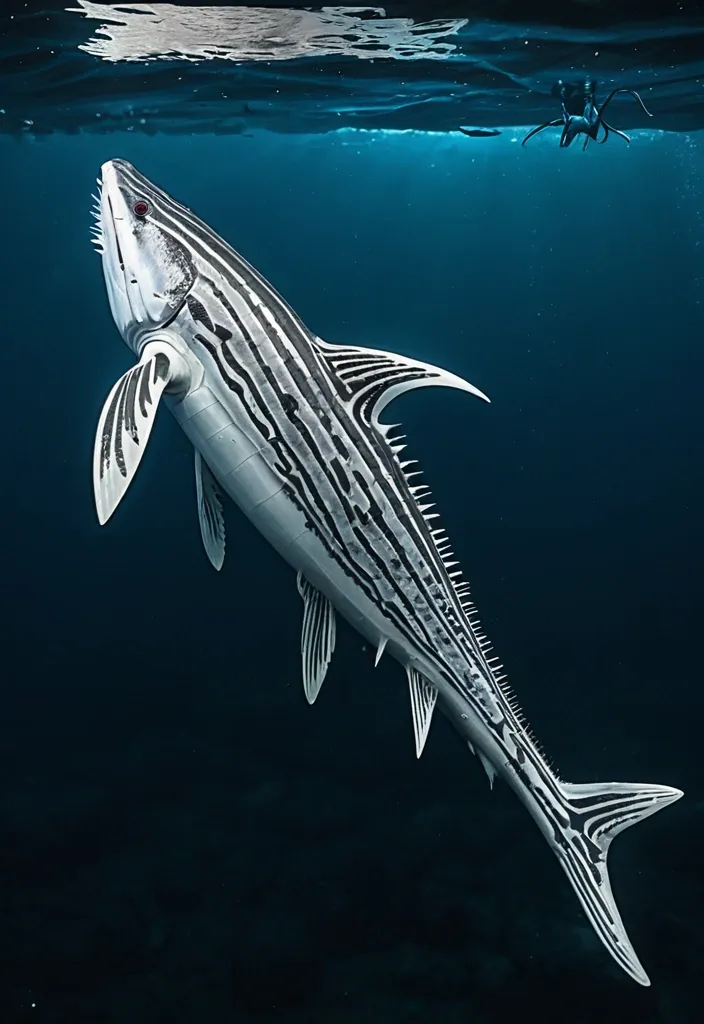
Physical Characteristics: Size & Weight: Between 40 to 60 feet in length , weighing 50 to 75 tons. Coloration: Females: Larger and more robust with black base and light gray tiger stripes , also featuring red bioluminescent patterns that pulse rhythmically. Body Structure: Hydrodynamic , muscular body combining the streamlined agility of the Shortfin Mako and Black Marlin with the robust power of Predator X and Megalodon. Rigid pectoral fins adapted from Black Marlin , capable of tilting back to reduce drag at high speeds. The tailend is a powerful fluke for propulsion , inspired by Mosasaurus Hoffmannii and Orca anatomy. Thick , overlapping bony scales similar to Arapaima , providing a durable armor that flexes with movement. Limbs: Powerful large flippers adapted for scooting or sliding on land , coated with mucus inspired by the Atlantic hagfish for moisture retention and defense. Capable of limited terrestrial movement , allowing brief excursions out of water. Head & Jaw: Massive jaws with over 40 , 000 PSI bite force , blending Predator X’s mighty jaw strength with the long canine teeth and powerful bite of the Leopard Seal. Flexible skull allowing swallowing of large prey whole. Respiration: Dual respiratory system with both functional lungs and gills , enabling survival from surface to abyssal depths (500 to 9 , 800 feet). Bioluminescence: Red bioluminescent photophores patterned in tiger stripes , used for communication , mating displays , and luring prey in the dark ocean depths. Abilities & Traits: Speed & Agility: Capable of bursts up to 82 mph , rivaling the fastest sea creatures like the Black Marlin. Agile hunter using stealth and passive listening , mimicking Transient Killer Whale hunting strategies. Social Structure: Small family groups of three (one male , two females) designed for efficient reproduction and hunting. Males are more streamlined and shorter , optimized for speed and power; females are larger , robust , and agile for endurance and nurturing. Regeneration: Remarkable limb regeneration inspired by axolotl and Crown-of-Thorns starfish , able to regrow lost fins , limbs , and even parts of internal organs. Defense: Venomous spines derived from Crown-of-Thorns starfish line its dorsal ridge , delivering painful venomous wounds to attackers. Mucus coating for defense and moisture retention , also making it slippery and difficult to grasp. Healing: A blubber-like layer similar to dolphins provides insulation , buoyancy , and antimicrobial properties that accelerate healing of wounds. Communication: Uses low-frequency growls , barks , and hisses inspired by saltwater crocodile sounds , combined with bioluminescent signals and stealth vocalizations for hunting. Reproduction: Live births occur at extreme depths (up to 9 , 800 feet) , with offspring adapted to survive in crushing pressures and cold temperatures. ,
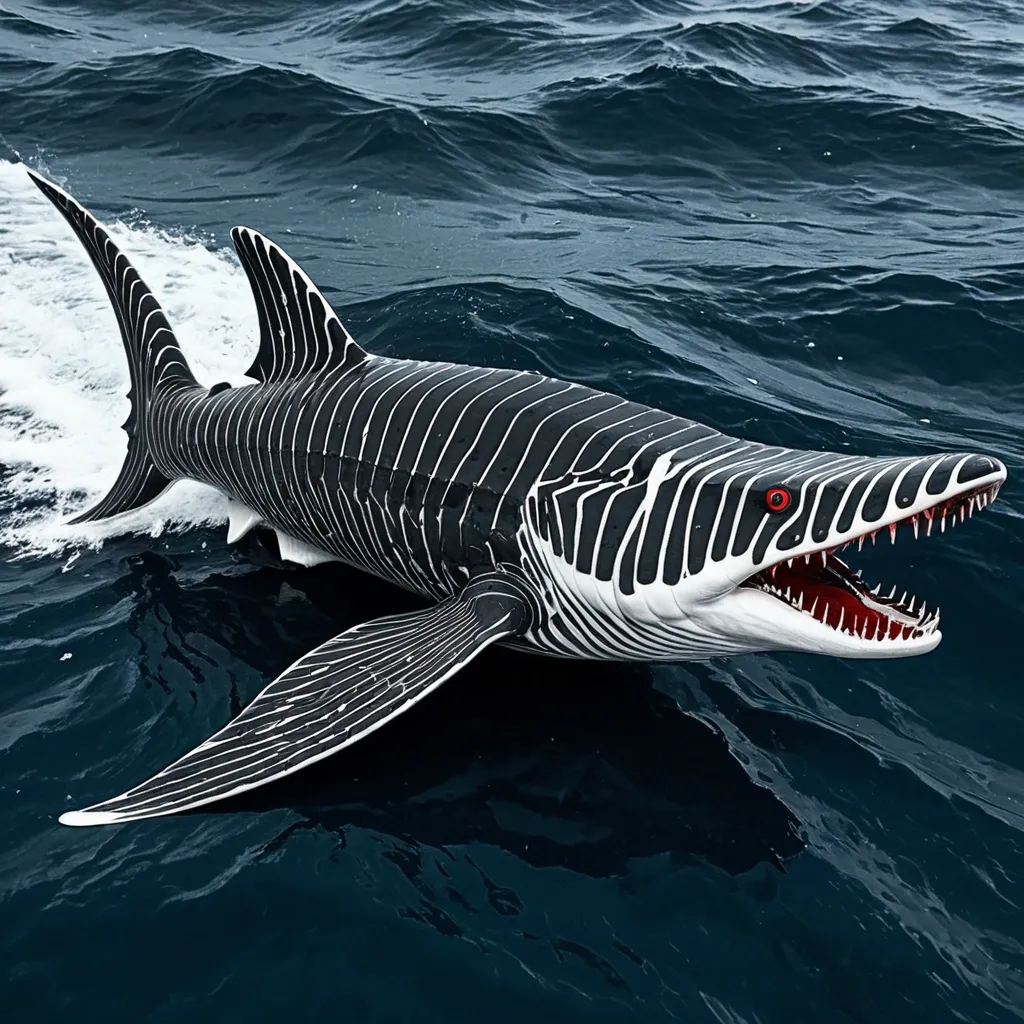
Physical Characteristics: Size & Weight: Between 40 to 60 feet in length , weighing 50 to 75 tons. Coloration: Females: Larger and more robust with black base and light gray tiger stripes , also featuring red bioluminescent patterns that pulse rhythmically. Body Structure: Hydrodynamic , muscular body combining the streamlined agility of the Shortfin Mako and Black Marlin with the robust power of Predator X and Megalodon. Rigid pectoral fins adapted from Black Marlin , capable of tilting back to reduce drag at high speeds. The tailend is a powerful fluke for propulsion , inspired by Mosasaurus Hoffmannii and Orca anatomy. Thick , overlapping bony scales similar to Arapaima , providing a durable armor that flexes with movement. Limbs: Powerful large flippers adapted for scooting or sliding on land , coated with mucus inspired by the Atlantic hagfish for moisture retention and defense. Capable of limited terrestrial movement , allowing brief excursions out of water. Head & Jaw: Massive jaws with over 40 , 000 PSI bite force , blending Predator X’s mighty jaw strength with the long canine teeth and powerful bite of the Leopard Seal. Flexible skull allowing swallowing of large prey whole. Respiration: Dual respiratory system with both functional lungs and gills , enabling survival from surface to abyssal depths (500 to 9 , 800 feet). Bioluminescence: Red bioluminescent photophores patterned in tiger stripes , used for communication , mating displays , and luring prey in the dark ocean depths. Abilities & Traits: Speed & Agility: Capable of bursts up to 82 mph , rivaling the fastest sea creatures like the Black Marlin. Agile hunter using stealth and passive listening , mimicking Transient Killer Whale hunting strategies. Social Structure: Small family groups of three (one male , two females) designed for efficient reproduction and hunting. Males are more streamlined and shorter , optimized for speed and power; females are larger , robust , and agile for endurance and nurturing. Regeneration: Remarkable limb regeneration inspired by axolotl and Crown-of-Thorns starfish , able to regrow lost fins , limbs , and even parts of internal organs. Defense: Venomous spines derived from Crown-of-Thorns starfish line its dorsal ridge , delivering painful venomous wounds to attackers. Mucus coating for defense and moisture retention , also making it slippery and difficult to grasp. Healing: A blubber-like layer similar to dolphins provides insulation , buoyancy , and antimicrobial properties that accelerate healing of wounds. Communication: Uses low-frequency growls , barks , and hisses inspired by saltwater crocodile sounds , combined with bioluminescent signals and stealth vocalizations for hunting. Reproduction: Live births occur at extreme depths (up to 9 , 800 feet) , with offspring adapted to survive in crushing pressures and cold temperatures. ,

Physical Characteristics: Size & Build: Towering at around 15 feet tall and 40 feet long , Venenosus Rex exhibits a robust , muscular build with bulky , reduced hind legs adapted for powerful knuckle-walking quadrupedal locomotion , inherited from its Ape DNA. Its stance is low and intimidating , allowing swift bursts of speed and stability. Head: The head is a terrifying blend of Tyrannosaurus rex , Giganotosaurus , and Triceratops shapes—a broad , armored skull with a reinforced bony frill and horn-like protrusions from Triceratops , providing natural defense. Its jaw can open up to 90 degrees , snake-like , capable of delivering crushing bites able to shatter bulletproof glass. Skin & Camouflage: Covered in thick , overlapping Scelidosaurus-like osteoderm armor plates along the back and flanks , providing excellent protection against attacks. The skin contains chromatophore cells from cuttlefish DNA , allowing Venenosus Rex to dynamically change skin color , texture , and pattern for camouflage or intimidation. Arms & Claws: Long , powerful arms inspired by Saurophaganax and Ape DNA end in razor-sharp , hooked claws capable of slashing through armored prey and wielding tools for complex hunting strategies. Teeth & Fangs: Teeth are a deadly combination from the Inland Taipan’s retractable fangs , Komodo Dragon’s serrated teeth , and Northern short-tailed shrew’s sharp incisors , allowing it to pierce armor and inject highly toxic saliva into prey. Eyes & Senses: Equipped with specialized cranial cavities housing infrared vision , enabling night hunting and detection of body heat signatures. Its olfactory and auditory senses are exceptionally refined due to Utahraptor and Komodo Dragon ancestry. Unique Abilities: Extreme Environmental Resistance: Thanks to Tardigrade , Opossum , and Mongoose DNA , Venenosus Rex can survive extreme temperatures , radiation , dehydration , starvation , and bacterial infections. Its organs are shielded by trehalose gel , and its DNA is protected by specialized proteins against radiation damage. It can slow its metabolism down to 0.01% of normal , entering a near-hibernative state during harsh conditions. Toxic Saliva & Venom: Its saliva contains potent neurotoxins and anticoagulants , ensuring even minor bites are deadly over time. Combined with its retractable fangs , it can efficiently incapacitate prey or rivals. Camouflage & Stealth: Dynamic skin color and texture changes allow it to blend seamlessly into diverse environments or mimic threatening patterns to intimidate. Intelligence & Pack Hunting: Enhanced Utahraptor DNA grants high cognitive abilities , including planning , problem-solving , and social pack hunting tactics , making it a highly strategic predator. Tool Use: The combination of long , dexterous arms and ape DNA allows it to manipulate objects , set traps , or use environmental tools during hunts. Wide Jaw Opening: The ability to open its jaw at a 90-degree angle allows for impressive bite range and prey handling , intimidating foes with sudden wide gapes. ,
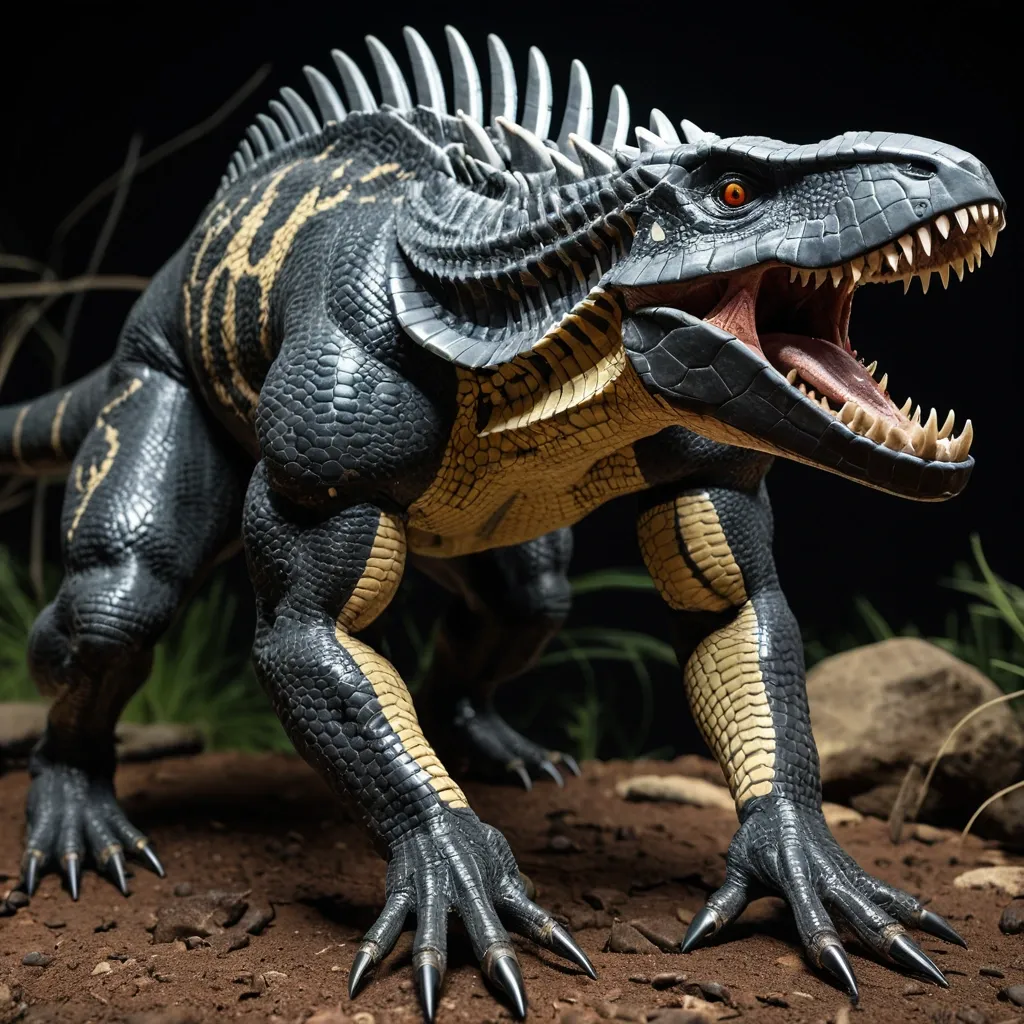
Physical Characteristics: Size & Build: Towering at around 15 feet tall and 40 feet long , Venenosus Rex exhibits a robust , muscular build with bulky , reduced hind legs adapted for powerful knuckle-walking quadrupedal locomotion , inherited from its Ape DNA. Its stance is low and intimidating , allowing swift bursts of speed and stability. Head: The head is a terrifying blend of Tyrannosaurus rex , Giganotosaurus , and Triceratops shapes—a broad , armored skull with a reinforced bony frill and horn-like protrusions from Triceratops , providing natural defense. Its jaw can open up to 90 degrees , snake-like , capable of delivering crushing bites able to shatter bulletproof glass. Skin & Camouflage: Covered in thick , overlapping Scelidosaurus-like osteoderm armor plates along the back and flanks , providing excellent protection against attacks. The skin contains chromatophore cells from cuttlefish DNA , allowing Venenosus Rex to dynamically change skin color , texture , and pattern for camouflage or intimidation. Arms & Claws: Long , powerful arms inspired by Saurophaganax and Ape DNA end in razor-sharp , hooked claws capable of slashing through armored prey and wielding tools for complex hunting strategies. Teeth & Fangs: Teeth are a deadly combination from the Inland Taipan’s retractable fangs , Komodo Dragon’s serrated teeth , and Northern short-tailed shrew’s sharp incisors , allowing it to pierce armor and inject highly toxic saliva into prey. Eyes & Senses: Equipped with specialized cranial cavities housing infrared vision , enabling night hunting and detection of body heat signatures. Its olfactory and auditory senses are exceptionally refined due to Utahraptor and Komodo Dragon ancestry. Unique Abilities: Extreme Environmental Resistance: Thanks to Tardigrade , Opossum , and Mongoose DNA , Venenosus Rex can survive extreme temperatures , radiation , dehydration , starvation , and bacterial infections. Its organs are shielded by trehalose gel , and its DNA is protected by specialized proteins against radiation damage. It can slow its metabolism down to 0.01% of normal , entering a near-hibernative state during harsh conditions. Toxic Saliva & Venom: Its saliva contains potent neurotoxins and anticoagulants , ensuring even minor bites are deadly over time. Combined with its retractable fangs , it can efficiently incapacitate prey or rivals. Camouflage & Stealth: Dynamic skin color and texture changes allow it to blend seamlessly into diverse environments or mimic threatening patterns to intimidate. Intelligence & Pack Hunting: Enhanced Utahraptor DNA grants high cognitive abilities , including planning , problem-solving , and social pack hunting tactics , making it a highly strategic predator. Tool Use: The combination of long , dexterous arms and ape DNA allows it to manipulate objects , set traps , or use environmental tools during hunts. Wide Jaw Opening: The ability to open its jaw at a 90-degree angle allows for impressive bite range and prey handling , intimidating foes with sudden wide gapes. ,

Physical Characteristics: Size & Build: Towering at around 15 feet tall and 40 feet long , Venenosus Rex exhibits a robust , muscular build with bulky , reduced hind legs adapted for powerful knuckle-walking quadrupedal locomotion , inherited from its Ape DNA. Its stance is low and intimidating , allowing swift bursts of speed and stability. Head: The head is a terrifying blend of Tyrannosaurus rex , Giganotosaurus , and Triceratops shapes—a broad , armored skull with a reinforced bony frill and horn-like protrusions from Triceratops , providing natural defense. Its jaw can open up to 90 degrees , snake-like , capable of delivering crushing bites able to shatter bulletproof glass. Skin & Camouflage: Covered in thick , overlapping Scelidosaurus-like osteoderm armor plates along the back and flanks , providing excellent protection against attacks. The skin contains chromatophore cells from cuttlefish DNA , allowing Venenosus Rex to dynamically change skin color , texture , and pattern for camouflage or intimidation. Arms & Claws: Long , powerful arms inspired by Saurophaganax and Ape DNA end in razor-sharp , hooked claws capable of slashing through armored prey and wielding tools for complex hunting strategies. Teeth & Fangs: Teeth are a deadly combination from the Inland Taipan’s retractable fangs , Komodo Dragon’s serrated teeth , and Northern short-tailed shrew’s sharp incisors , allowing it to pierce armor and inject highly toxic saliva into prey. Eyes & Senses: Equipped with specialized cranial cavities housing infrared vision , enabling night hunting and detection of body heat signatures. Its olfactory and auditory senses are exceptionally refined due to Utahraptor and Komodo Dragon ancestry. Unique Abilities: Extreme Environmental Resistance: Thanks to Tardigrade , Opossum , and Mongoose DNA , Venenosus Rex can survive extreme temperatures , radiation , dehydration , starvation , and bacterial infections. Its organs are shielded by trehalose gel , and its DNA is protected by specialized proteins against radiation damage. It can slow its metabolism down to 0.01% of normal , entering a near-hibernative state during harsh conditions. Toxic Saliva & Venom: Its saliva contains potent neurotoxins and anticoagulants , ensuring even minor bites are deadly over time. Combined with its retractable fangs , it can efficiently incapacitate prey or rivals. Camouflage & Stealth: Dynamic skin color and texture changes allow it to blend seamlessly into diverse environments or mimic threatening patterns to intimidate. Intelligence & Pack Hunting: Enhanced Utahraptor DNA grants high cognitive abilities , including planning , problem-solving , and social pack hunting tactics , making it a highly strategic predator. Tool Use: The combination of long , dexterous arms and ape DNA allows it to manipulate objects , set traps , or use environmental tools during hunts. Wide Jaw Opening: The ability to open its jaw at a 90-degree angle allows for impressive bite range and prey handling , intimidating foes with sudden wide gapes. ,
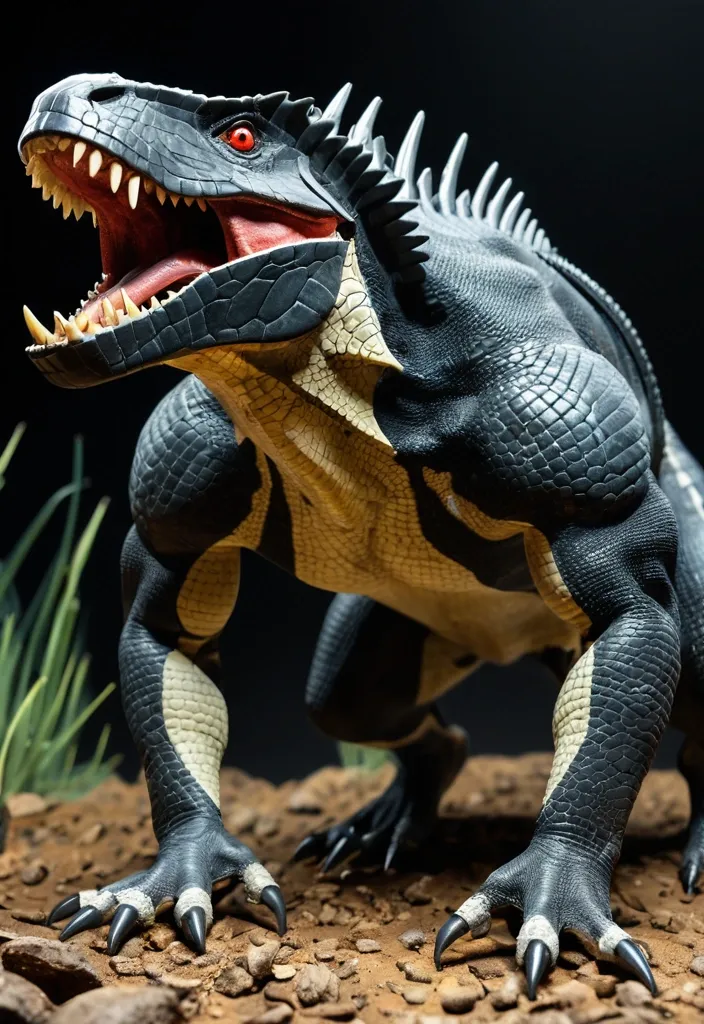
Physical Characteristics: Size & Build: Towering at around 15 feet tall and 40 feet long , Venenosus Rex exhibits a robust , muscular build with bulky , reduced hind legs adapted for powerful knuckle-walking quadrupedal locomotion , inherited from its Ape DNA. Its stance is low and intimidating , allowing swift bursts of speed and stability. Head: The head is a terrifying blend of Tyrannosaurus rex , Giganotosaurus , and Triceratops shapes—a broad , armored skull with a reinforced bony frill and horn-like protrusions from Triceratops , providing natural defense. Its jaw can open up to 90 degrees , snake-like , capable of delivering crushing bites able to shatter bulletproof glass. Skin & Camouflage: Covered in thick , overlapping Scelidosaurus-like osteoderm armor plates along the back and flanks , providing excellent protection against attacks. The skin contains chromatophore cells from cuttlefish DNA , allowing Venenosus Rex to dynamically change skin color , texture , and pattern for camouflage or intimidation. Arms & Claws: Long , powerful arms inspired by Saurophaganax and Ape DNA end in razor-sharp , hooked claws capable of slashing through armored prey and wielding tools for complex hunting strategies. Teeth & Fangs: Teeth are a deadly combination from the Inland Taipan’s retractable fangs , Komodo Dragon’s serrated teeth , and Northern short-tailed shrew’s sharp incisors , allowing it to pierce armor and inject highly toxic saliva into prey. Eyes & Senses: Equipped with specialized cranial cavities housing infrared vision , enabling night hunting and detection of body heat signatures. Its olfactory and auditory senses are exceptionally refined due to Utahraptor and Komodo Dragon ancestry. Unique Abilities: Extreme Environmental Resistance: Thanks to Tardigrade , Opossum , and Mongoose DNA , Venenosus Rex can survive extreme temperatures , radiation , dehydration , starvation , and bacterial infections. Its organs are shielded by trehalose gel , and its DNA is protected by specialized proteins against radiation damage. It can slow its metabolism down to 0.01% of normal , entering a near-hibernative state during harsh conditions. Toxic Saliva & Venom: Its saliva contains potent neurotoxins and anticoagulants , ensuring even minor bites are deadly over time. Combined with its retractable fangs , it can efficiently incapacitate prey or rivals. Camouflage & Stealth: Dynamic skin color and texture changes allow it to blend seamlessly into diverse environments or mimic threatening patterns to intimidate. Intelligence & Pack Hunting: Enhanced Utahraptor DNA grants high cognitive abilities , including planning , problem-solving , and social pack hunting tactics , making it a highly strategic predator. Tool Use: The combination of long , dexterous arms and ape DNA allows it to manipulate objects , set traps , or use environmental tools during hunts. Wide Jaw Opening: The ability to open its jaw at a 90-degree angle allows for impressive bite range and prey handling , intimidating foes with sudden wide gapes. ,
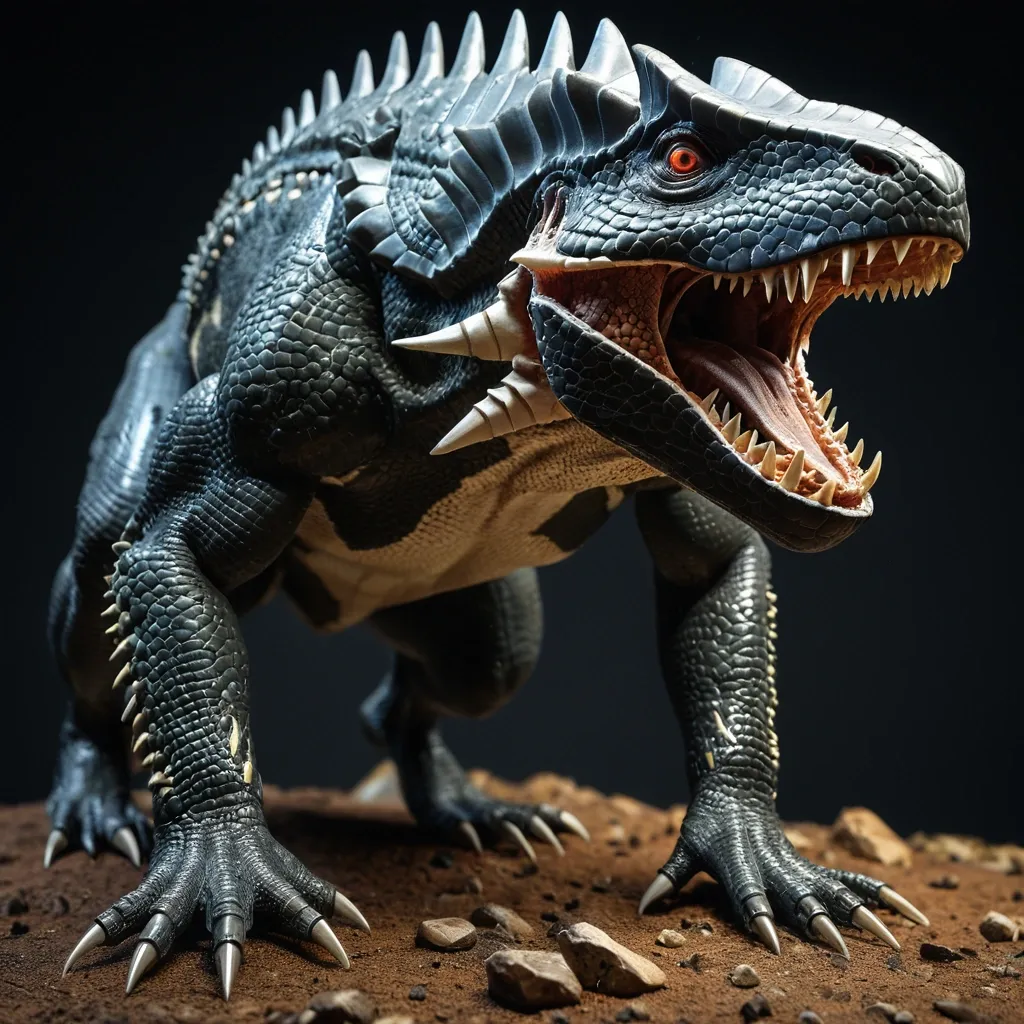
Physical Characteristics: Size & Build: Towering at around 15 feet tall and 40 feet long , Venenosus Rex exhibits a robust , muscular build with bulky , reduced hind legs adapted for powerful knuckle-walking quadrupedal locomotion , inherited from its Ape DNA. Its stance is low and intimidating , allowing swift bursts of speed and stability. Head: The head is a terrifying blend of Tyrannosaurus rex , Giganotosaurus , and Triceratops shapes—a broad , armored skull with a reinforced bony frill and horn-like protrusions from Triceratops , providing natural defense. Its jaw can open up to 90 degrees , snake-like , capable of delivering crushing bites able to shatter bulletproof glass. Skin & Camouflage: Covered in thick , overlapping Scelidosaurus-like osteoderm armor plates along the back and flanks , providing excellent protection against attacks. The skin contains chromatophore cells from cuttlefish DNA , allowing Venenosus Rex to dynamically change skin color , texture , and pattern for camouflage or intimidation. Arms & Claws: Long , powerful arms inspired by Saurophaganax and Ape DNA end in razor-sharp , hooked claws capable of slashing through armored prey and wielding tools for complex hunting strategies. Teeth & Fangs: Teeth are a deadly combination from the Inland Taipan’s retractable fangs , Komodo Dragon’s serrated teeth , and Northern short-tailed shrew’s sharp incisors , allowing it to pierce armor and inject highly toxic saliva into prey. Eyes & Senses: Equipped with specialized cranial cavities housing infrared vision , enabling night hunting and detection of body heat signatures. Its olfactory and auditory senses are exceptionally refined due to Utahraptor and Komodo Dragon ancestry. Unique Abilities: Extreme Environmental Resistance: Thanks to Tardigrade , Opossum , and Mongoose DNA , Venenosus Rex can survive extreme temperatures , radiation , dehydration , starvation , and bacterial infections. Its organs are shielded by trehalose gel , and its DNA is protected by specialized proteins against radiation damage. It can slow its metabolism down to 0.01% of normal , entering a near-hibernative state during harsh conditions. Toxic Saliva & Venom: Its saliva contains potent neurotoxins and anticoagulants , ensuring even minor bites are deadly over time. Combined with its retractable fangs , it can efficiently incapacitate prey or rivals. Camouflage & Stealth: Dynamic skin color and texture changes allow it to blend seamlessly into diverse environments or mimic threatening patterns to intimidate. Intelligence & Pack Hunting: Enhanced Utahraptor DNA grants high cognitive abilities , including planning , problem-solving , and social pack hunting tactics , making it a highly strategic predator. Tool Use: The combination of long , dexterous arms and ape DNA allows it to manipulate objects , set traps , or use environmental tools during hunts. Wide Jaw Opening: The ability to open its jaw at a 90-degree angle allows for impressive bite range and prey handling , intimidating foes with sudden wide gapes. ,
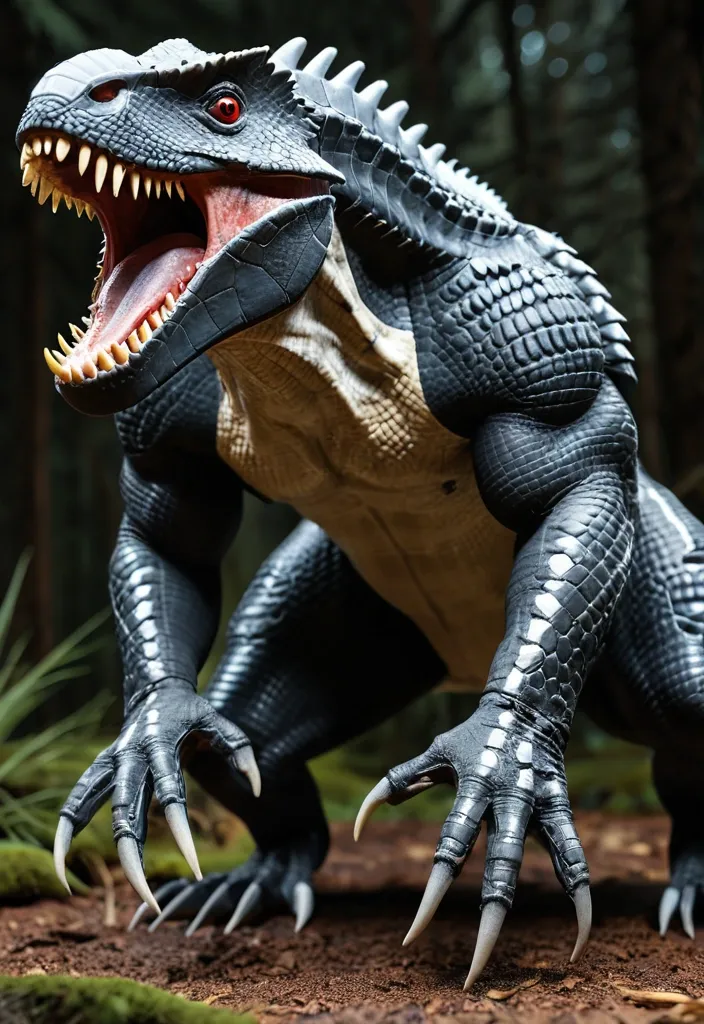
Physical Characteristics: Size & Build: Towering at around 15 feet tall and 40 feet long , Venenosus Rex exhibits a robust , muscular build with bulky , reduced hind legs adapted for powerful knuckle-walking quadrupedal locomotion , inherited from its Ape DNA. Its stance is low and intimidating , allowing swift bursts of speed and stability. Head: The head is a terrifying blend of Tyrannosaurus rex , Giganotosaurus , and Triceratops shapes—a broad , armored skull with a reinforced bony frill and horn-like protrusions from Triceratops , providing natural defense. Its jaw can open up to 90 degrees , snake-like , capable of delivering crushing bites able to shatter bulletproof glass. Skin & Camouflage: Covered in thick , overlapping Scelidosaurus-like osteoderm armor plates along the back and flanks , providing excellent protection against attacks. The skin contains chromatophore cells from cuttlefish DNA , allowing Venenosus Rex to dynamically change skin color , texture , and pattern for camouflage or intimidation. Arms & Claws: Long , powerful arms inspired by Saurophaganax and Ape DNA end in razor-sharp , hooked claws capable of slashing through armored prey and wielding tools for complex hunting strategies. Teeth & Fangs: Teeth are a deadly combination from the Inland Taipan’s retractable fangs , Komodo Dragon’s serrated teeth , and Northern short-tailed shrew’s sharp incisors , allowing it to pierce armor and inject highly toxic saliva into prey. Eyes & Senses: Equipped with specialized cranial cavities housing infrared vision , enabling night hunting and detection of body heat signatures. Its olfactory and auditory senses are exceptionally refined due to Utahraptor and Komodo Dragon ancestry. Unique Abilities: Extreme Environmental Resistance: Thanks to Tardigrade , Opossum , and Mongoose DNA , Venenosus Rex can survive extreme temperatures , radiation , dehydration , starvation , and bacterial infections. Its organs are shielded by trehalose gel , and its DNA is protected by specialized proteins against radiation damage. It can slow its metabolism down to 0.01% of normal , entering a near-hibernative state during harsh conditions. Toxic Saliva & Venom: Its saliva contains potent neurotoxins and anticoagulants , ensuring even minor bites are deadly over time. Combined with its retractable fangs , it can efficiently incapacitate prey or rivals. Camouflage & Stealth: Dynamic skin color and texture changes allow it to blend seamlessly into diverse environments or mimic threatening patterns to intimidate. Intelligence & Pack Hunting: Enhanced Utahraptor DNA grants high cognitive abilities , including planning , problem-solving , and social pack hunting tactics , making it a highly strategic predator. Tool Use: The combination of long , dexterous arms and ape DNA allows it to manipulate objects , set traps , or use environmental tools during hunts. Wide Jaw Opening: The ability to open its jaw at a 90-degree angle allows for impressive bite range and prey handling , intimidating foes with sudden wide gapes. ,
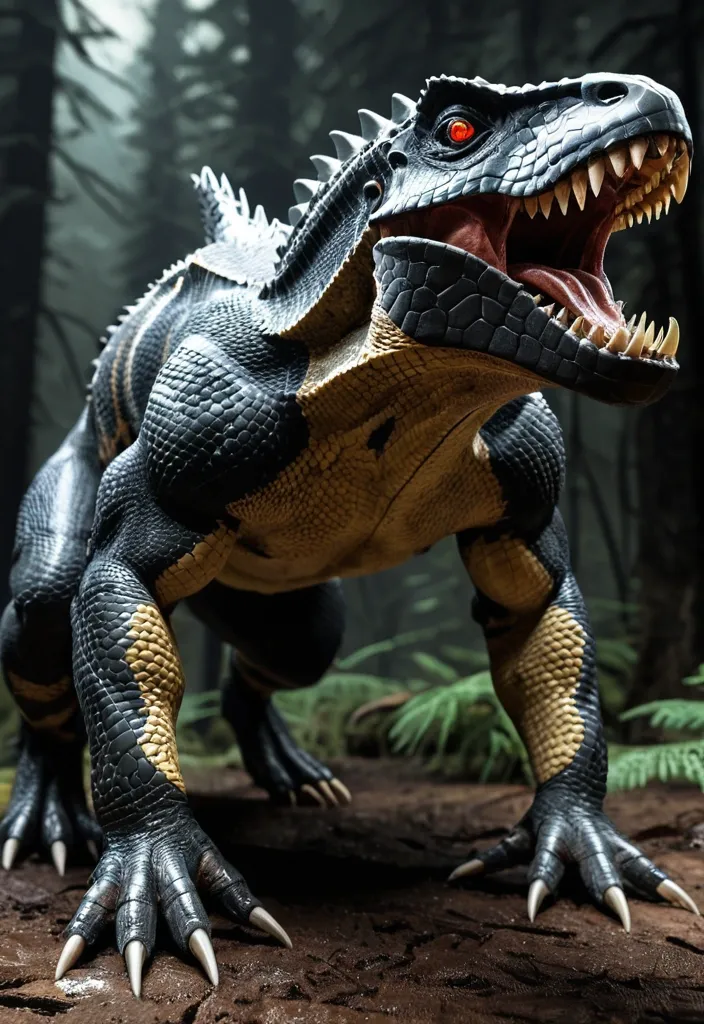
Physical Characteristics: Size & Build: Towering at around 15 feet tall and 40 feet long , Venenosus Rex exhibits a robust , muscular build with bulky , reduced hind legs adapted for powerful knuckle-walking quadrupedal locomotion , inherited from its Ape DNA. Its stance is low and intimidating , allowing swift bursts of speed and stability. Head: The head is a terrifying blend of Tyrannosaurus rex , Giganotosaurus , and Triceratops shapes—a broad , armored skull with a reinforced bony frill and horn-like protrusions from Triceratops , providing natural defense. Its jaw can open up to 90 degrees , snake-like , capable of delivering crushing bites able to shatter bulletproof glass. Skin & Camouflage: Covered in thick , overlapping Scelidosaurus-like osteoderm armor plates along the back and flanks , providing excellent protection against attacks. The skin contains chromatophore cells from cuttlefish DNA , allowing Venenosus Rex to dynamically change skin color , texture , and pattern for camouflage or intimidation. Arms & Claws: Long , powerful arms inspired by Saurophaganax and Ape DNA end in razor-sharp , hooked claws capable of slashing through armored prey and wielding tools for complex hunting strategies. Teeth & Fangs: Teeth are a deadly combination from the Inland Taipan’s retractable fangs , Komodo Dragon’s serrated teeth , and Northern short-tailed shrew’s sharp incisors , allowing it to pierce armor and inject highly toxic saliva into prey. Eyes & Senses: Equipped with specialized cranial cavities housing infrared vision , enabling night hunting and detection of body heat signatures. Its olfactory and auditory senses are exceptionally refined due to Utahraptor and Komodo Dragon ancestry. Unique Abilities: Extreme Environmental Resistance: Thanks to Tardigrade , Opossum , and Mongoose DNA , Venenosus Rex can survive extreme temperatures , radiation , dehydration , starvation , and bacterial infections. Its organs are shielded by trehalose gel , and its DNA is protected by specialized proteins against radiation damage. It can slow its metabolism down to 0.01% of normal , entering a near-hibernative state during harsh conditions. Toxic Saliva & Venom: Its saliva contains potent neurotoxins and anticoagulants , ensuring even minor bites are deadly over time. Combined with its retractable fangs , it can efficiently incapacitate prey or rivals. Camouflage & Stealth: Dynamic skin color and texture changes allow it to blend seamlessly into diverse environments or mimic threatening patterns to intimidate. Intelligence & Pack Hunting: Enhanced Utahraptor DNA grants high cognitive abilities , including planning , problem-solving , and social pack hunting tactics , making it a highly strategic predator. Tool Use: The combination of long , dexterous arms and ape DNA allows it to manipulate objects , set traps , or use environmental tools during hunts. Wide Jaw Opening: The ability to open its jaw at a 90-degree angle allows for impressive bite range and prey handling , intimidating foes with sudden wide gapes. ,
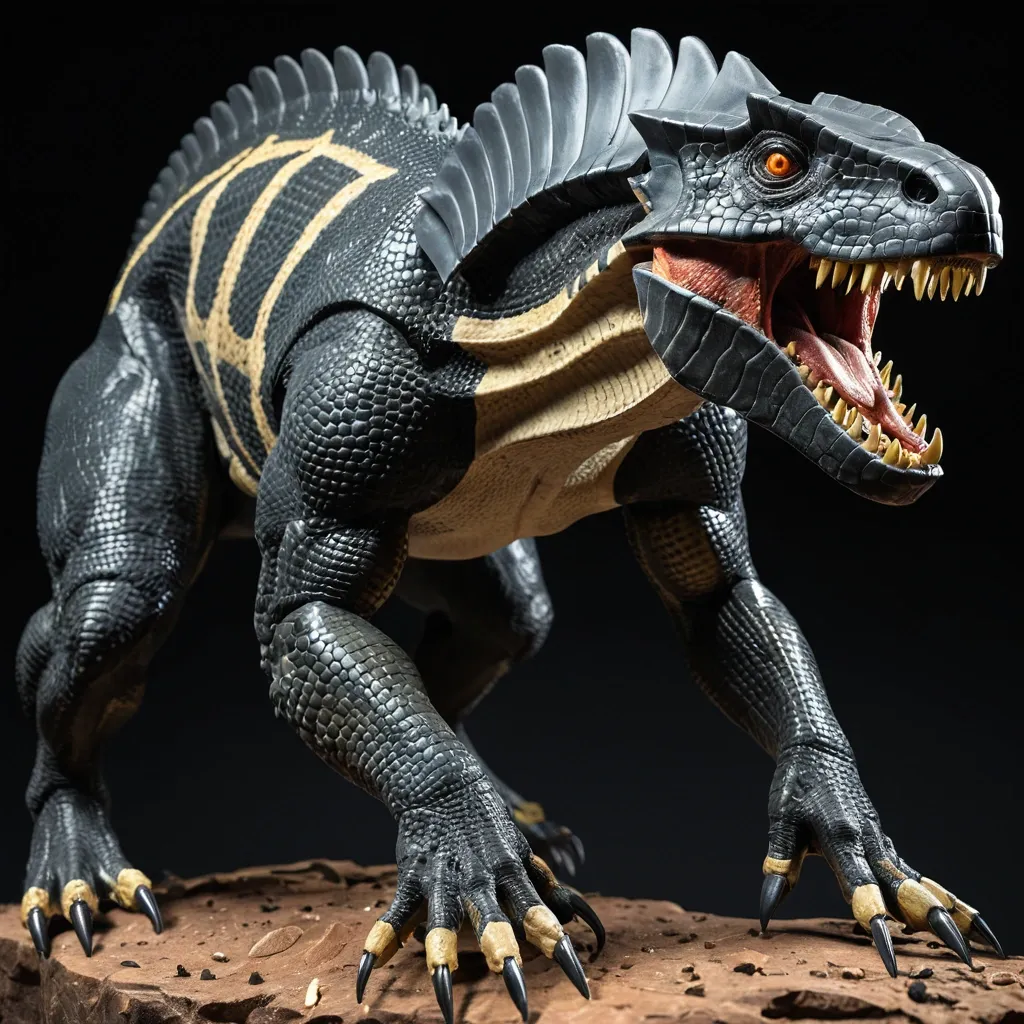
Physical Characteristics: Size & Build: Towering at around 15 feet tall and 40 feet long , Venenosus Rex exhibits a robust , muscular build with bulky , reduced hind legs adapted for powerful knuckle-walking quadrupedal locomotion , inherited from its Ape DNA. Its stance is low and intimidating , allowing swift bursts of speed and stability. Head: The head is a terrifying blend of Tyrannosaurus rex , Giganotosaurus , and Triceratops shapes—a broad , armored skull with a reinforced bony frill and horn-like protrusions from Triceratops , providing natural defense. Its jaw can open up to 90 degrees , snake-like , capable of delivering crushing bites able to shatter bulletproof glass. Skin & Camouflage: Covered in thick , overlapping Scelidosaurus-like osteoderm armor plates along the back and flanks , providing excellent protection against attacks. The skin contains chromatophore cells from cuttlefish DNA , allowing Venenosus Rex to dynamically change skin color , texture , and pattern for camouflage or intimidation. Arms & Claws: Long , powerful arms inspired by Saurophaganax and Ape DNA end in razor-sharp , hooked claws capable of slashing through armored prey and wielding tools for complex hunting strategies. Teeth & Fangs: Teeth are a deadly combination from the Inland Taipan’s retractable fangs , Komodo Dragon’s serrated teeth , and Northern short-tailed shrew’s sharp incisors , allowing it to pierce armor and inject highly toxic saliva into prey. Eyes & Senses: Equipped with specialized cranial cavities housing infrared vision , enabling night hunting and detection of body heat signatures. Its olfactory and auditory senses are exceptionally refined due to Utahraptor and Komodo Dragon ancestry. Unique Abilities: Extreme Environmental Resistance: Thanks to Tardigrade , Opossum , and Mongoose DNA , Venenosus Rex can survive extreme temperatures , radiation , dehydration , starvation , and bacterial infections. Its organs are shielded by trehalose gel , and its DNA is protected by specialized proteins against radiation damage. It can slow its metabolism down to 0.01% of normal , entering a near-hibernative state during harsh conditions. Toxic Saliva & Venom: Its saliva contains potent neurotoxins and anticoagulants , ensuring even minor bites are deadly over time. Combined with its retractable fangs , it can efficiently incapacitate prey or rivals. Camouflage & Stealth: Dynamic skin color and texture changes allow it to blend seamlessly into diverse environments or mimic threatening patterns to intimidate. Intelligence & Pack Hunting: Enhanced Utahraptor DNA grants high cognitive abilities , including planning , problem-solving , and social pack hunting tactics , making it a highly strategic predator. Tool Use: The combination of long , dexterous arms and ape DNA allows it to manipulate objects , set traps , or use environmental tools during hunts. Wide Jaw Opening: The ability to open its jaw at a 90-degree angle allows for impressive bite range and prey handling , intimidating foes with sudden wide gapes. ,
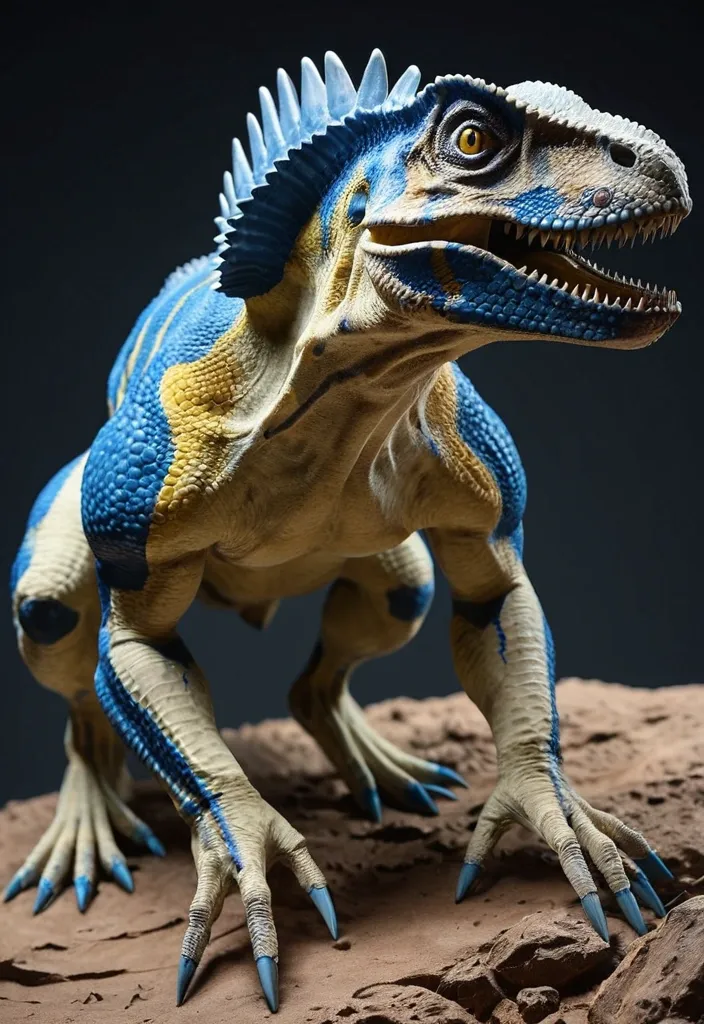
The hybrid was created by modifying the genome of a Tyrannosaurus rex , with the DNA of three other theropod species that were Utahraptor , Saurophaganax , and Giganotosaurus. Also the DNA of Quadrupes like Triceratops , and Scelidosaurus. DNA of modern animals such as Greater blue-ringed octopus , Inland Taipan , Northern Short-tailed Shrew , Komodo Dragon , Opossum , Mongoose , Gigantopithecus , Whiptail Lizard , Cuttlefish , and Tardigrades. The genome of Tyrannosaurus rex , Triceratops and Giganotosaurus was used as the base genome for the hybrid. Including the shape of the head in some parts from Giganotosaurus and Triceratops. Utahraptor DNA was added for high levels of intelligence and the ability to make plans , decisions and pack hunting. Reduced hind legs and Ape DNA added Knuckle-walking Quadruped. Triceratops , and Scelidosaurus were added to act as a biological form of armor that absorbed most of the incoming attacks. Northern short-tailed shrew , the Inland taipan's retractable fangs and the Komodo Dragon DNA was used to form the teeth of the Indominus that were used to tear through the flesh and armor of opponents. Saurophaganax and Gigantopithecus DNA added the presence of long strong arms with slashing hook claws and the use of tools. A swipe of the hybrid's claws would take down bigger opponents. While using tools for smaller elusive prey. Cuttlefish genes were intended to help the Venenosus withstand an accelerated growth , but it also added chromatophore cells in the skin so it could change the shape , color , and texture of its skin like a cuttlefish. Opossum , Mongoose and Tardigrades DNA was added for the Venenosus to be more resistant to climate changes , harmful toxins or bacterial infections , while tardigrades also added survival of extreme conditions such as exposure to extreme temperatures , extreme pressures , air deprivation , radiation , dehydration , and starvation. They have several defense mechanisms , including: A metabolic rate that gets as low as 0.01 percent of the normal rate. Organs protected by a sugary gel called trehalose. A protein that shields their DNA from radiation harm. Synthesis of cryoprotectant in chilly temperatures to prevent the development of ice crystals.Northern short-tailed shrew , the Inland Taipan , Greater blue-ringed octopus and the Komodo Dragon's DNA also added special cavities and glands in the skull that gave her infrared vision , and highly toxic saliva. Said DNA also gave her the ability to open her mandibles and jaws as wide as a snake , specifically at around 90 degrees.Lastly , DNA from a whiptail lizard was added for reproduction purposes. ,
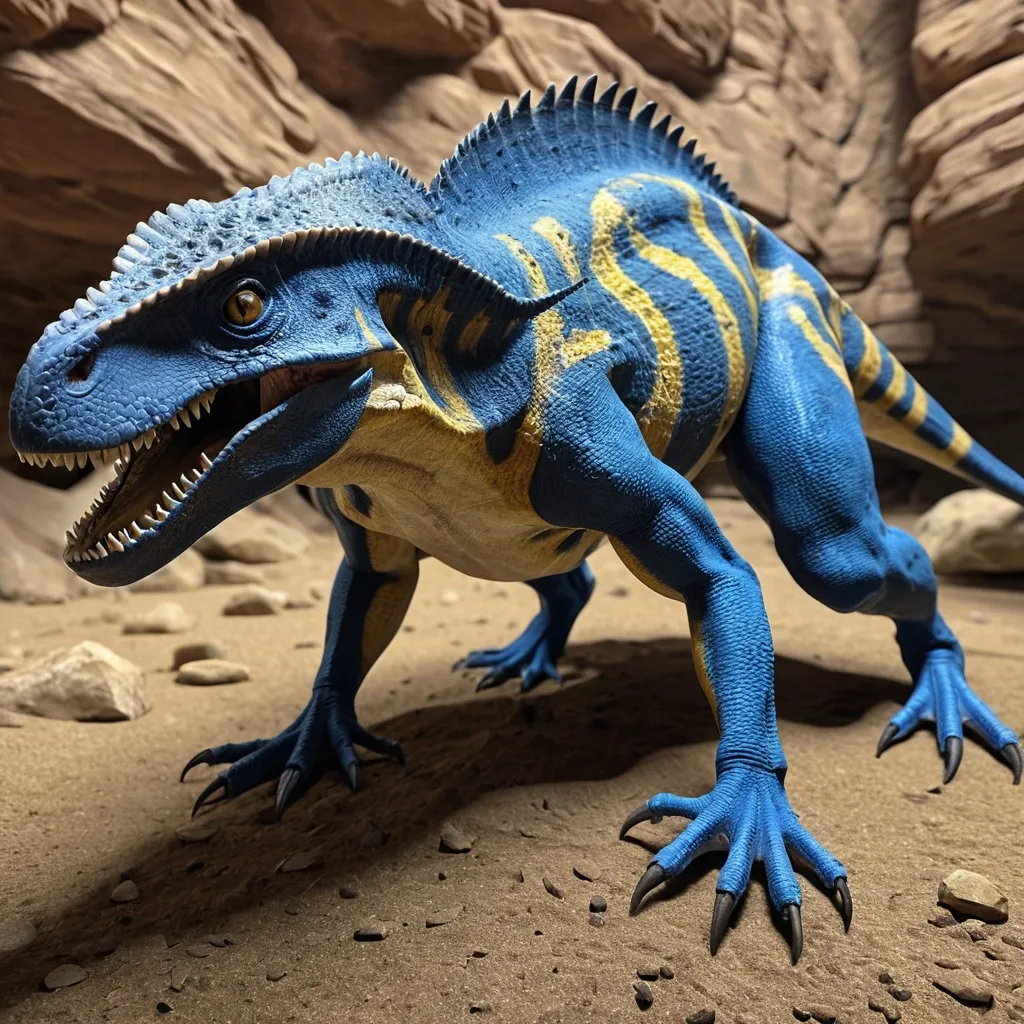
The hybrid was created by modifying the genome of a Tyrannosaurus rex , with the DNA of three other theropod species that were Utahraptor , Saurophaganax , and Giganotosaurus. Also the DNA of Quadrupes like Triceratops , and Scelidosaurus. DNA of modern animals such as Greater blue-ringed octopus , Inland Taipan , Northern Short-tailed Shrew , Komodo Dragon , Opossum , Mongoose , Gigantopithecus , Whiptail Lizard , Cuttlefish , and Tardigrades. The genome of Tyrannosaurus rex , Triceratops and Giganotosaurus was used as the base genome for the hybrid. Including the shape of the head in some parts from Giganotosaurus and Triceratops. Utahraptor DNA was added for high levels of intelligence and the ability to make plans , decisions and pack hunting. Reduced hind legs and Ape DNA added Knuckle-walking Quadruped. Triceratops , and Scelidosaurus were added to act as a biological form of armor that absorbed most of the incoming attacks. Northern short-tailed shrew , the Inland taipan's retractable fangs and the Komodo Dragon DNA was used to form the teeth of the Indominus that were used to tear through the flesh and armor of opponents. Saurophaganax and Gigantopithecus DNA added the presence of long strong arms with slashing hook claws and the use of tools. A swipe of the hybrid's claws would take down bigger opponents. While using tools for smaller elusive prey. Cuttlefish genes were intended to help the Venenosus withstand an accelerated growth , but it also added chromatophore cells in the skin so it could change the shape , color , and texture of its skin like a cuttlefish. Opossum , Mongoose and Tardigrades DNA was added for the Venenosus to be more resistant to climate changes , harmful toxins or bacterial infections , while tardigrades also added survival of extreme conditions such as exposure to extreme temperatures , extreme pressures , air deprivation , radiation , dehydration , and starvation. They have several defense mechanisms , including: A metabolic rate that gets as low as 0.01 percent of the normal rate. Organs protected by a sugary gel called trehalose. A protein that shields their DNA from radiation harm. Synthesis of cryoprotectant in chilly temperatures to prevent the development of ice crystals.Northern short-tailed shrew , the Inland Taipan , Greater blue-ringed octopus and the Komodo Dragon's DNA also added special cavities and glands in the skull that gave her infrared vision , and highly toxic saliva. Said DNA also gave her the ability to open her mandibles and jaws as wide as a snake , specifically at around 90 degrees.Lastly , DNA from a whiptail lizard was added for reproduction purposes. ,
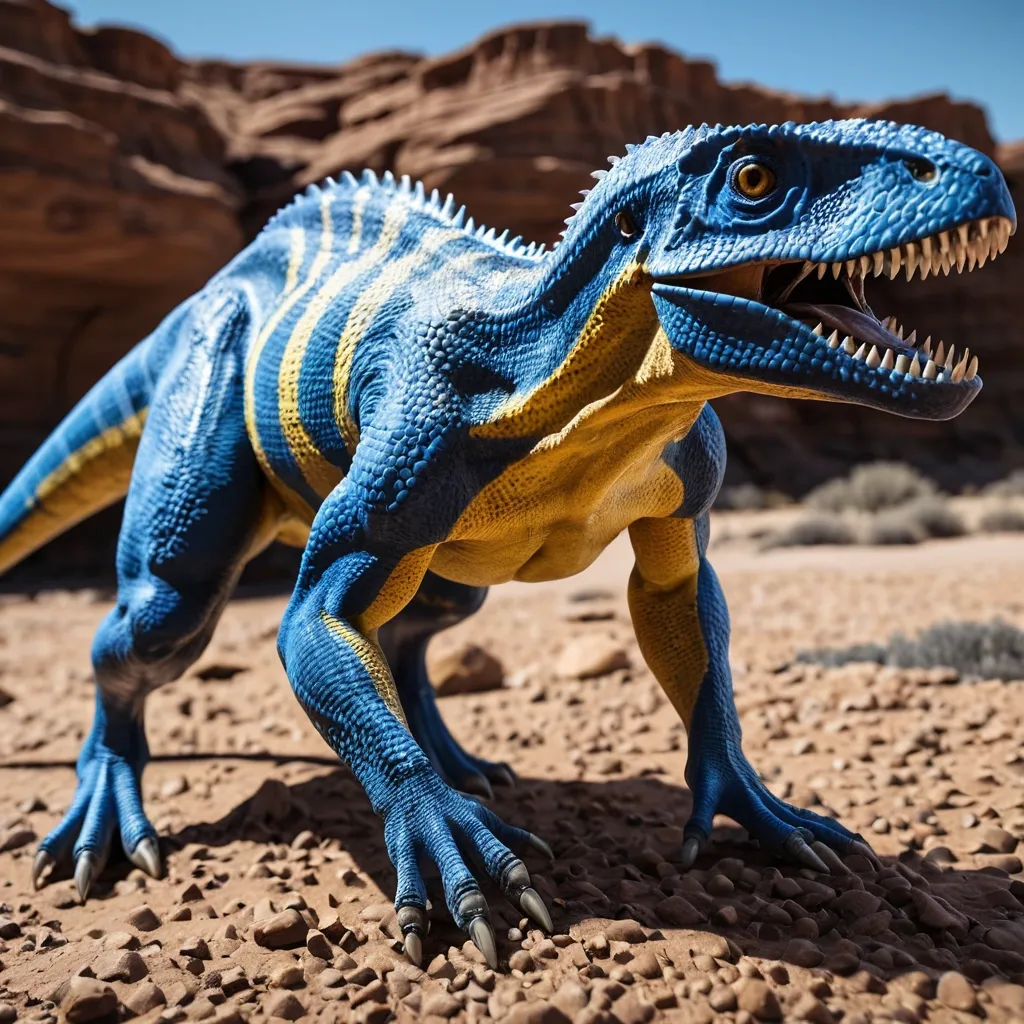
The hybrid was created by modifying the genome of a Tyrannosaurus rex , with the DNA of three other theropod species that were Utahraptor , Saurophaganax , and Giganotosaurus. Also the DNA of Quadrupes like Triceratops , and Scelidosaurus. DNA of modern animals such as Greater blue-ringed octopus , Inland Taipan , Northern Short-tailed Shrew , Komodo Dragon , Opossum , Mongoose , Gigantopithecus , Whiptail Lizard , Cuttlefish , and Tardigrades. The genome of Tyrannosaurus rex , Triceratops and Giganotosaurus was used as the base genome for the hybrid. Including the shape of the head in some parts from Giganotosaurus and Triceratops. Utahraptor DNA was added for high levels of intelligence and the ability to make plans , decisions and pack hunting. Reduced hind legs and Ape DNA added Knuckle-walking Quadruped. Triceratops , and Scelidosaurus were added to act as a biological form of armor that absorbed most of the incoming attacks. Northern short-tailed shrew , the Inland taipan's retractable fangs and the Komodo Dragon DNA was used to form the teeth of the Indominus that were used to tear through the flesh and armor of opponents. Saurophaganax and Gigantopithecus DNA added the presence of long strong arms with slashing hook claws and the use of tools. A swipe of the hybrid's claws would take down bigger opponents. While using tools for smaller elusive prey. Cuttlefish genes were intended to help the Venenosus withstand an accelerated growth , but it also added chromatophore cells in the skin so it could change the shape , color , and texture of its skin like a cuttlefish. Opossum , Mongoose and Tardigrades DNA was added for the Venenosus to be more resistant to climate changes , harmful toxins or bacterial infections , while tardigrades also added survival of extreme conditions such as exposure to extreme temperatures , extreme pressures , air deprivation , radiation , dehydration , and starvation. They have several defense mechanisms , including: A metabolic rate that gets as low as 0.01 percent of the normal rate. Organs protected by a sugary gel called trehalose. A protein that shields their DNA from radiation harm. Synthesis of cryoprotectant in chilly temperatures to prevent the development of ice crystals.Northern short-tailed shrew , the Inland Taipan , Greater blue-ringed octopus and the Komodo Dragon's DNA also added special cavities and glands in the skull that gave her infrared vision , and highly toxic saliva. Said DNA also gave her the ability to open her mandibles and jaws as wide as a snake , specifically at around 90 degrees.Lastly , DNA from a whiptail lizard was added for reproduction purposes. ,
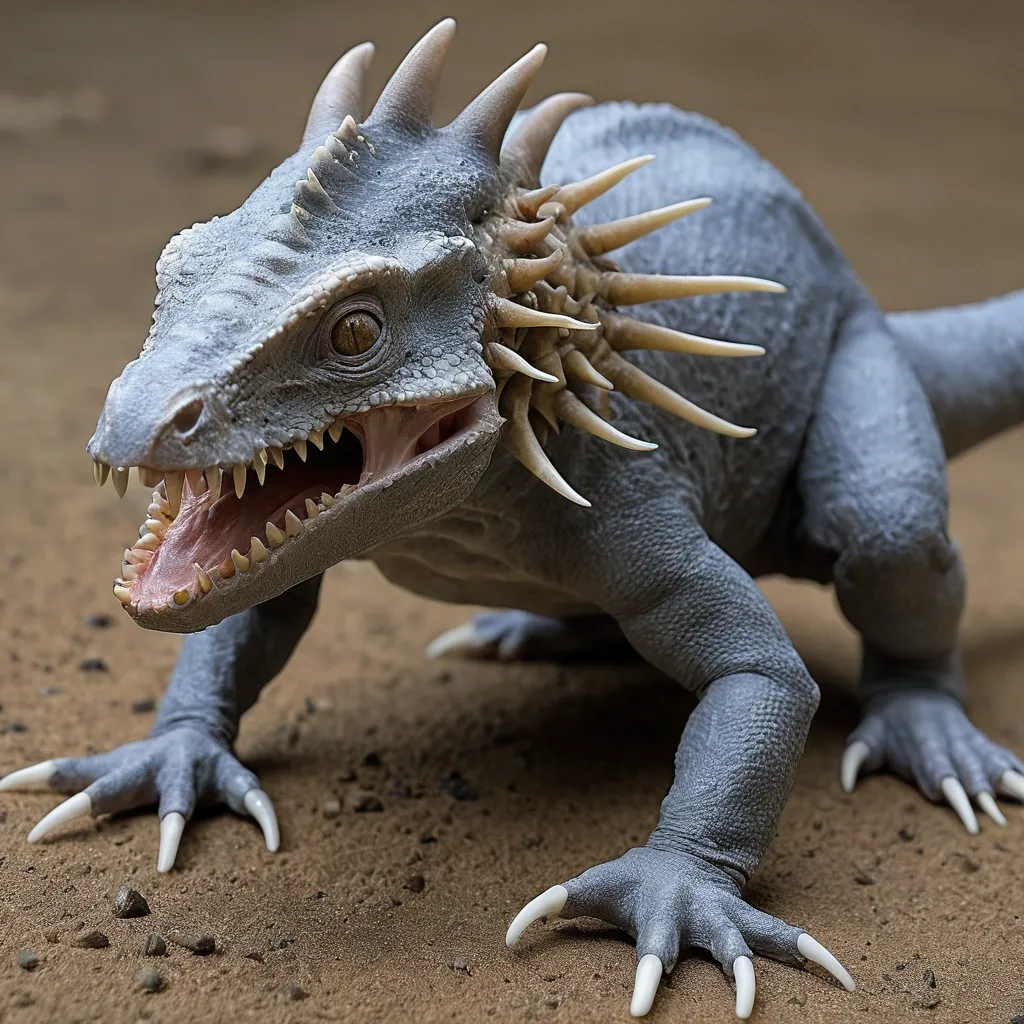
The genome of Tyrannosaurus rex , Triceratops and Giganotosaurus was used as the base genome for the hybrid. Including the shape of the head in some parts from Triceratops. Utahraptor DNA was added for high levels of intelligence and the ability to make plans , decisions and pack hunting. Reduced hind legs and Ape DNA added Knuckle-walking Quadruped. Triceratops , and Scelidosaurus were added to act as a biological form of armor that absorbed most of the incoming attacks. Northern short-tailed shrew , the Inland taipan's retractable fangs and the Komodo Dragon DNA was used to form the teeth of the Indominus that were used to tear through the flesh and armor of opponents. Saurophaganax and Gigantopithecus DNA added the presence of long strong arms with slashing hook claws and the use of tools. A swipe of the hybrid's claws would take down bigger opponents. While using tools for smaller elusive prey. Cuttlefish genes were intended to help the Venenosus withstand an accelerated growth , but it also added chromatophore cells in the skin so it could change the shape , color , and texture of its skin like a cuttlefish. Opossum , Mongoose and Tardigrades DNA was added for the Venenosus to be more resistant to climate changes , harmful toxins or bacterial infections , while tardigrades also added survival of extreme conditions such as exposure to extreme temperatures , extreme pressures , air deprivation , radiation , dehydration , and starvation. They have several defense mechanisms , including: A metabolic rate that gets as low as 0.01 percent of the normal rate. Organs protected by a sugary gel called trehalose. A protein that shields their DNA from radiation harm. Synthesis of cryoprotectant in chilly temperatures to prevent the development of ice crystals.Northern short-tailed shrew , the Inland Taipan , Greater blue-ringed octopus and the Komodo Dragon's DNA also added special cavities and glands in the skull that gave her infrared vision , and highly toxic saliva. Said DNA also gave her the ability to open her mandibles and jaws as wide as a snake , specifically at around 90 degrees.Lastly , DNA from a whiptail lizard was added for reproduction purposes. ,
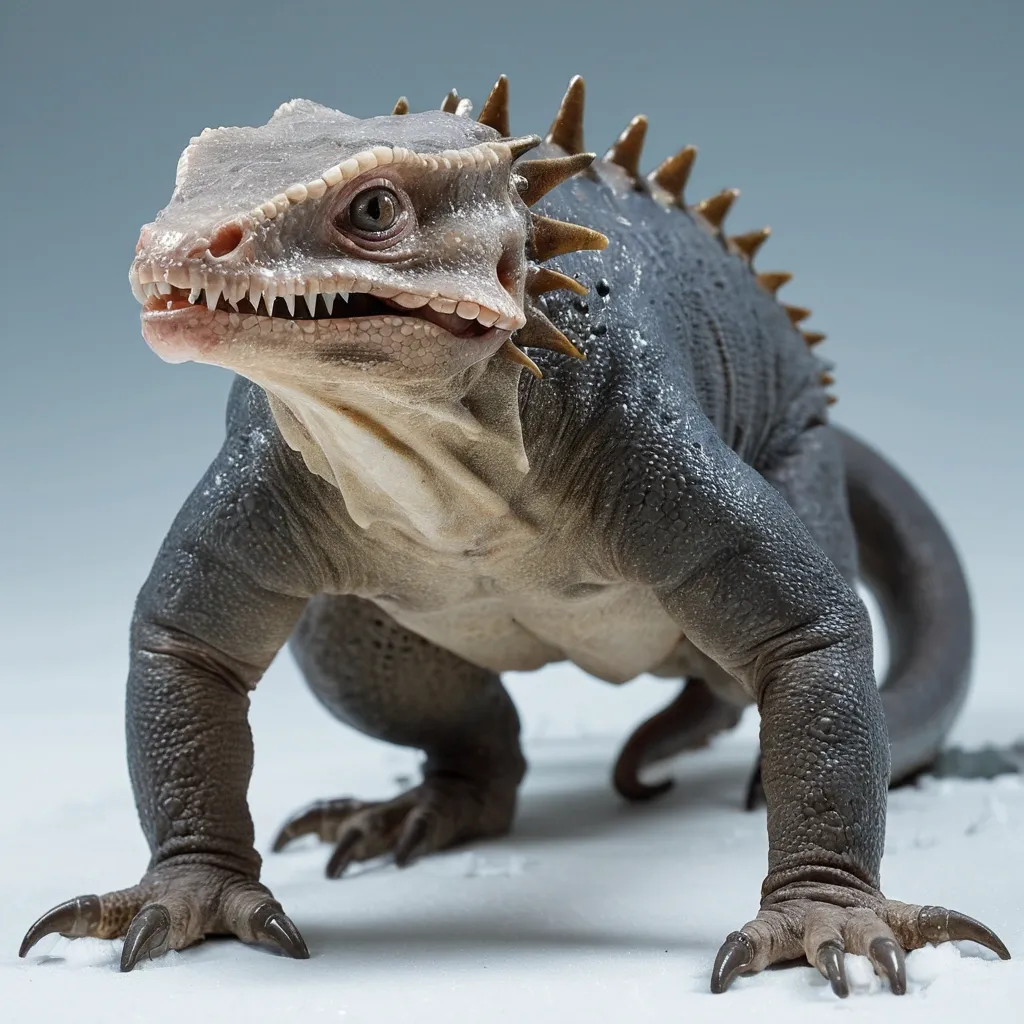
The genome of Tyrannosaurus rex , Triceratops and Giganotosaurus was used as the base genome for the hybrid. Including the shape of the head in some parts from Triceratops. Utahraptor DNA was added for high levels of intelligence and the ability to make plans , decisions and pack hunting. Reduced hind legs and Ape DNA added Knuckle-walking Quadruped. Triceratops , and Scelidosaurus were added to act as a biological form of armor that absorbed most of the incoming attacks. Northern short-tailed shrew , the Inland taipan's retractable fangs and the Komodo Dragon DNA was used to form the teeth of the Indominus that were used to tear through the flesh and armor of opponents. Saurophaganax and Gigantopithecus DNA added the presence of long strong arms with slashing hook claws and the use of tools. A swipe of the hybrid's claws would take down bigger opponents. While using tools for smaller elusive prey. Cuttlefish genes were intended to help the Venenosus withstand an accelerated growth , but it also added chromatophore cells in the skin so it could change the shape , color , and texture of its skin like a cuttlefish. Opossum , Mongoose and Tardigrades DNA was added for the Venenosus to be more resistant to climate changes , harmful toxins or bacterial infections , while tardigrades also added survival of extreme conditions such as exposure to extreme temperatures , extreme pressures , air deprivation , radiation , dehydration , and starvation. They have several defense mechanisms , including: A metabolic rate that gets as low as 0.01 percent of the normal rate. Organs protected by a sugary gel called trehalose. A protein that shields their DNA from radiation harm. Synthesis of cryoprotectant in chilly temperatures to prevent the development of ice crystals.Northern short-tailed shrew , the Inland Taipan , Greater blue-ringed octopus and the Komodo Dragon's DNA also added special cavities and glands in the skull that gave her infrared vision , and highly toxic saliva. Said DNA also gave her the ability to open her mandibles and jaws as wide as a snake , specifically at around 90 degrees.Lastly , DNA from a whiptail lizard was added for reproduction purposes. ,
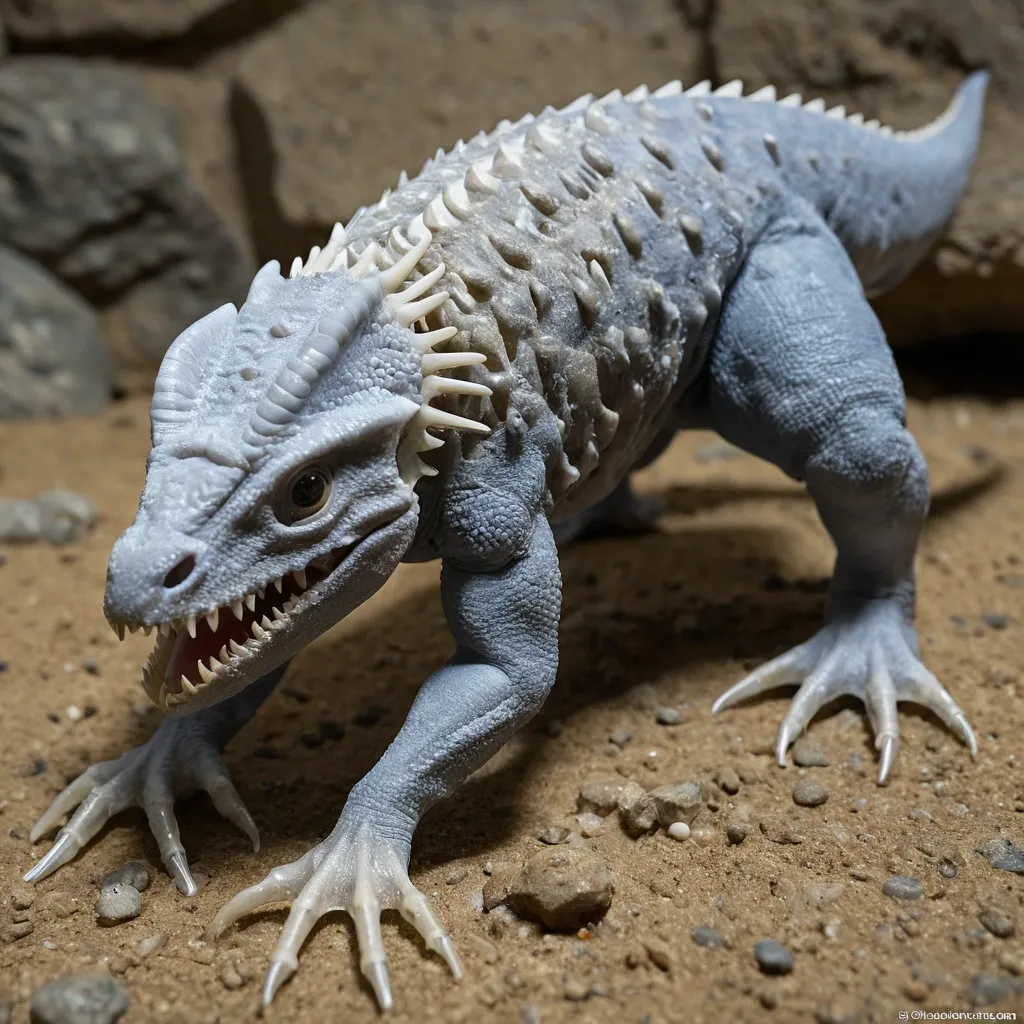
The genome of Tyrannosaurus rex , Triceratops and Giganotosaurus was used as the base genome for the hybrid. Including the shape of the head in some parts from Triceratops. Utahraptor DNA was added for high levels of intelligence and the ability to make plans , decisions and pack hunting. Reduced hind legs and Ape DNA added Knuckle-walking Quadruped. Triceratops , and Scelidosaurus were added to act as a biological form of armor that absorbed most of the incoming attacks. Northern short-tailed shrew , the Inland taipan's retractable fangs and the Komodo Dragon DNA was used to form the teeth of the Indominus that were used to tear through the flesh and armor of opponents. Saurophaganax and Gigantopithecus DNA added the presence of long strong arms with slashing hook claws and the use of tools. A swipe of the hybrid's claws would take down bigger opponents. While using tools for smaller elusive prey. Cuttlefish genes were intended to help the Venenosus withstand an accelerated growth , but it also added chromatophore cells in the skin so it could change the shape , color , and texture of its skin like a cuttlefish. Opossum , Mongoose and Tardigrades DNA was added for the Venenosus to be more resistant to climate changes , harmful toxins or bacterial infections , while tardigrades also added survival of extreme conditions such as exposure to extreme temperatures , extreme pressures , air deprivation , radiation , dehydration , and starvation. They have several defense mechanisms , including: A metabolic rate that gets as low as 0.01 percent of the normal rate. Organs protected by a sugary gel called trehalose. A protein that shields their DNA from radiation harm. Synthesis of cryoprotectant in chilly temperatures to prevent the development of ice crystals.Northern short-tailed shrew , the Inland Taipan , Greater blue-ringed octopus and the Komodo Dragon's DNA also added special cavities and glands in the skull that gave her infrared vision , and highly toxic saliva. Said DNA also gave her the ability to open her mandibles and jaws as wide as a snake , specifically at around 90 degrees.Lastly , DNA from a whiptail lizard was added for reproduction purposes. ,
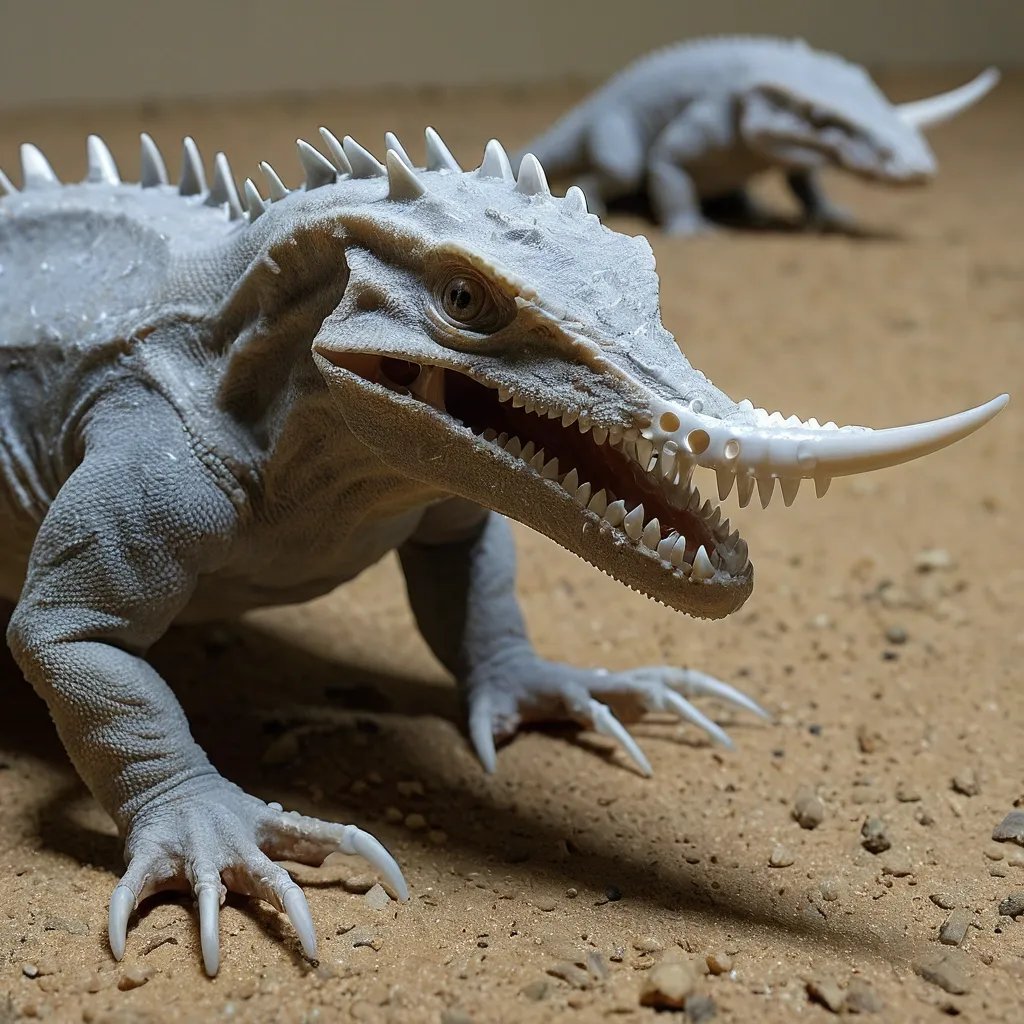
The genome of Tyrannosaurus rex , Triceratops and Giganotosaurus was used as the base genome for the hybrid. Including the shape of the head in some parts from Triceratops. Utahraptor DNA was added for high levels of intelligence and the ability to make plans , decisions and pack hunting. Reduced hind legs and Ape DNA added Knuckle-walking Quadruped. Triceratops , and Scelidosaurus were added to act as a biological form of armor that absorbed most of the incoming attacks. Northern short-tailed shrew , the Inland taipan's retractable fangs and the Komodo Dragon DNA was used to form the teeth of the Indominus that were used to tear through the flesh and armor of opponents. Saurophaganax and Gigantopithecus DNA added the presence of long strong arms with slashing hook claws and the use of tools. A swipe of the hybrid's claws would take down bigger opponents. While using tools for smaller elusive prey. Cuttlefish genes were intended to help the Venenosus withstand an accelerated growth , but it also added chromatophore cells in the skin so it could change the shape , color , and texture of its skin like a cuttlefish. Opossum , Mongoose and Tardigrades DNA was added for the Venenosus to be more resistant to climate changes , harmful toxins or bacterial infections , while tardigrades also added survival of extreme conditions such as exposure to extreme temperatures , extreme pressures , air deprivation , radiation , dehydration , and starvation. They have several defense mechanisms , including: A metabolic rate that gets as low as 0.01 percent of the normal rate. Organs protected by a sugary gel called trehalose. A protein that shields their DNA from radiation harm. Synthesis of cryoprotectant in chilly temperatures to prevent the development of ice crystals.Northern short-tailed shrew , the Inland Taipan , Greater blue-ringed octopus and the Komodo Dragon's DNA also added special cavities and glands in the skull that gave her infrared vision , and highly toxic saliva. Said DNA also gave her the ability to open her mandibles and jaws as wide as a snake , specifically at around 90 degrees.Lastly , DNA from a whiptail lizard was added for reproduction purposes. ,

The genome of Tyrannosaurus rex , Triceratops and Giganotosaurus was used as the base genome for the hybrid. Including the shape of the head in some parts from Giganotosaurus and Triceratops. It also gave the Indominus rex an incredibly strong bite that could crush bulletproof glass. Utahraptor DNA was added for high levels of intelligence and the ability to make plans , decisions and pack hunting. Reduced hind legs and Ape DNA added Knuckle-walking Quadruped. Triceratops , and Scelidosaurus were added to act as a biological form of armor that absorbed most of the incoming attacks. Northern short-tailed shrew , the Inland taipan's retractable fangs and the Komodo Dragon DNA was used to form the teeth of the Indominus that were used to tear through the flesh and armor of opponents. Saurophaganax and Gigantopithecus DNA added the presence of long strong arms with slashing hook claws and the use of tools. A swipe of the hybrid's claws would take down bigger opponents. While using tools for smaller elusive prey. Cuttlefish genes were intended to help the Venenosus withstand an accelerated growth , but it also added chromatophore cells in the skin so it could change the shape , color , and texture of its skin like a cuttlefish. Opossum , Mongoose and Tardigrades DNA was added for the Venenosus to be more resistant to climate changes , harmful toxins or bacterial infections , while tardigrades also added survival of extreme conditions such as exposure to extreme temperatures , extreme pressures , air deprivation , radiation , dehydration , and starvation. They have several defense mechanisms , including: A metabolic rate that gets as low as 0.01 percent of the normal rate. Organs protected by a sugary gel called trehalose. A protein that shields their DNA from radiation harm. Synthesis of cryoprotectant in chilly temperatures to prevent the development of ice crystals.Northern short-tailed shrew , the Inland Taipan , Greater blue-ringed octopus and the Komodo Dragon's DNA also added special cavities and glands in the skull that gave her infrared vision , and highly toxic saliva. Said DNA also gave her the ability to open her mandibles and jaws as wide as a snake , specifically at around 90 degrees.Lastly , DNA from a whiptail lizard was added for reproduction purposes. ,
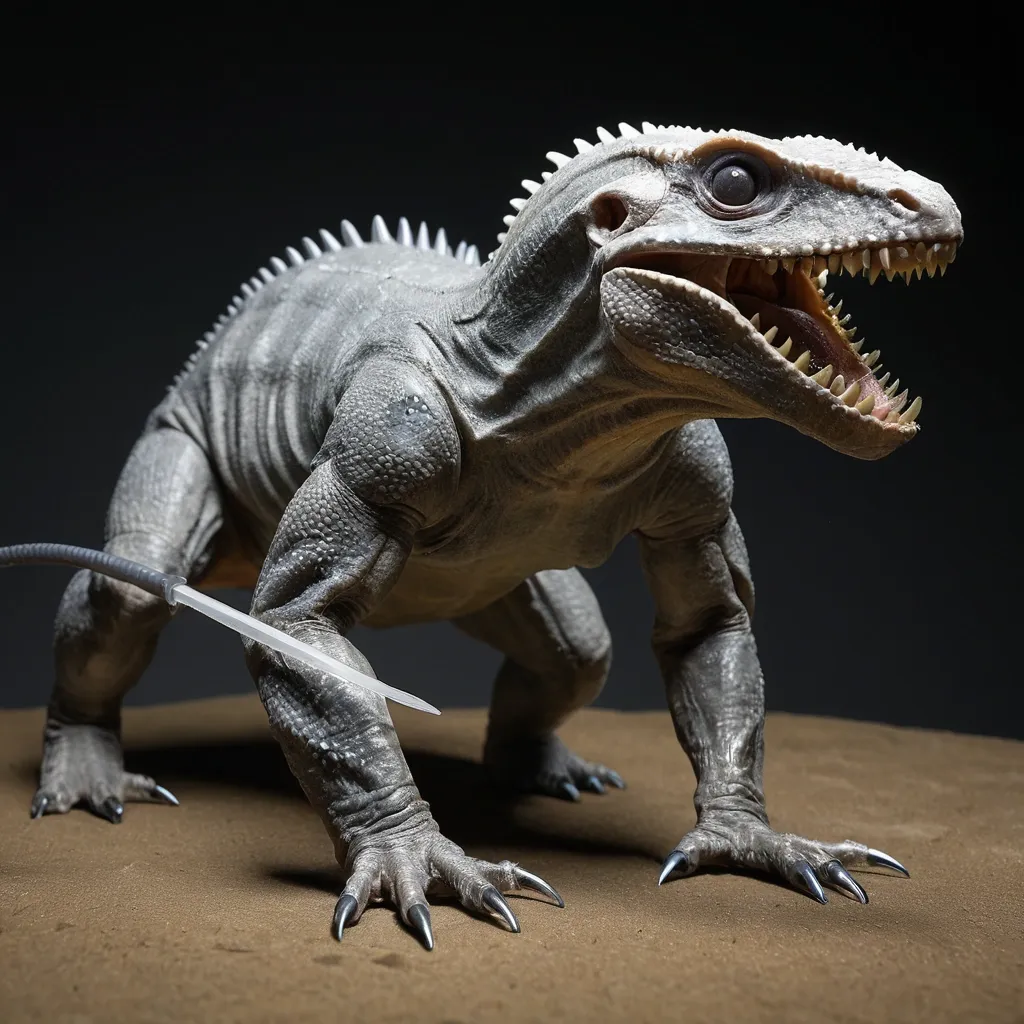
The genome of Tyrannosaurus rex , Triceratops and Giganotosaurus was used as the base genome for the hybrid. Including the shape of the head in some parts from Giganotosaurus and Triceratops. It also gave the Indominus rex an incredibly strong bite that could crush bulletproof glass. Utahraptor DNA was added for high levels of intelligence and the ability to make plans , decisions and pack hunting. Reduced hind legs and Ape DNA added Knuckle-walking Quadruped. Triceratops , and Scelidosaurus were added to act as a biological form of armor that absorbed most of the incoming attacks. Northern short-tailed shrew , the Inland taipan's retractable fangs and the Komodo Dragon DNA was used to form the teeth of the Indominus that were used to tear through the flesh and armor of opponents. Saurophaganax and Gigantopithecus DNA added the presence of long strong arms with slashing hook claws and the use of tools. A swipe of the hybrid's claws would take down bigger opponents. While using tools for smaller elusive prey. Cuttlefish genes were intended to help the Venenosus withstand an accelerated growth , but it also added chromatophore cells in the skin so it could change the shape , color , and texture of its skin like a cuttlefish. Opossum , Mongoose and Tardigrades DNA was added for the Venenosus to be more resistant to climate changes , harmful toxins or bacterial infections , while tardigrades also added survival of extreme conditions such as exposure to extreme temperatures , extreme pressures , air deprivation , radiation , dehydration , and starvation. They have several defense mechanisms , including: A metabolic rate that gets as low as 0.01 percent of the normal rate. Organs protected by a sugary gel called trehalose. A protein that shields their DNA from radiation harm. Synthesis of cryoprotectant in chilly temperatures to prevent the development of ice crystals.Northern short-tailed shrew , the Inland Taipan , Greater blue-ringed octopus and the Komodo Dragon's DNA also added special cavities and glands in the skull that gave her infrared vision , and highly toxic saliva. Said DNA also gave her the ability to open her mandibles and jaws as wide as a snake , specifically at around 90 degrees.Lastly , DNA from a whiptail lizard was added for reproduction purposes. ,
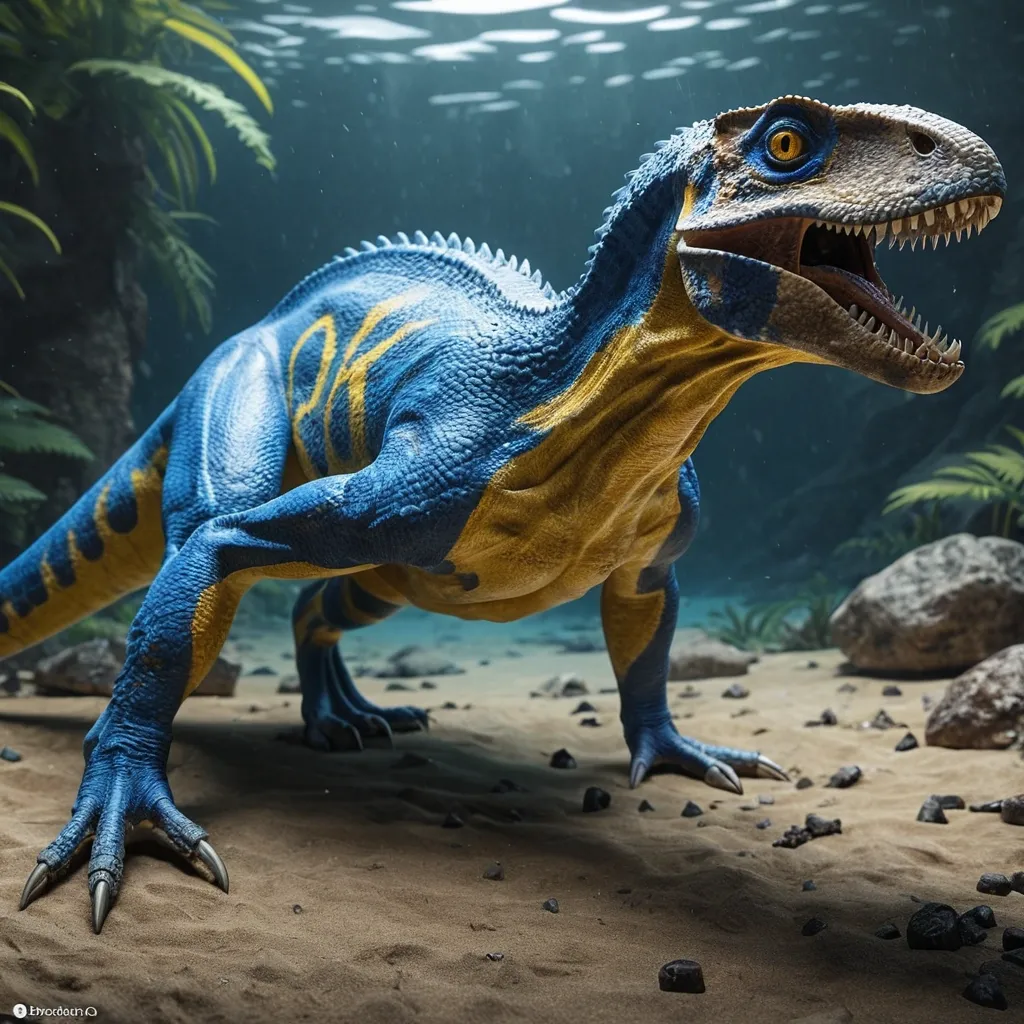
The hybrid was created by modifying the genome of a Tyrannosaurus rex , with the DNA of three other theropod species that were Utahraptor , Saurophaganax , and Giganotosaurus. Also the DNA of Quadrupes like Triceratops , and Scelidosaurus. DNA of modern animals such as Greater blue-ringed octopus , Inland Taipan , Northern Short-tailed Shrew , Komodo Dragon , Opossum , Mongoose , Gigantopithecus , Whiptail Lizard , Cuttlefish , and Tardigrades. The genome of Tyrannosaurus rex , Triceratops and Giganotosaurus was used as the base genome for the hybrid. Including the shape of the head in some parts from Giganotosaurus and Triceratops. It also gave the Indominus rex an incredibly strong bite that could crush bulletproof glass. Utahraptor DNA was added for high levels of intelligence and the ability to make plans , decisions and pack hunting. Reduced hind legs and Ape DNA added Knuckle-walking Quadruped. Triceratops , and Scelidosaurus were added to act as a biological form of armor that absorbed most of the incoming attacks. Northern short-tailed shrew , the Inland taipan's retractable fangs and the Komodo Dragon DNA was used to form the teeth of the Indominus that were used to tear through the flesh and armor of opponents. Saurophaganax and Gigantopithecus DNA added the presence of long strong arms with slashing hook claws and the use of tools. A swipe of the hybrid's claws would take down bigger opponents. While using tools for smaller elusive prey. Cuttlefish genes were intended to help the Venenosus withstand an accelerated growth , but it also added chromatophore cells in the skin so it could change the shape , color , and texture of its skin like a cuttlefish. Opossum , Mongoose and Tardigrades DNA was added for the Venenosus to be more resistant to climate changes , harmful toxins or bacterial infections , while tardigrades also added survival of extreme conditions such as exposure to extreme temperatures , extreme pressures , air deprivation , radiation , dehydration , and starvation. They have several defense mechanisms , including: A metabolic rate that gets as low as 0.01 percent of the normal rate. Organs protected by a sugary gel called trehalose. A protein that shields their DNA from radiation harm. Synthesis of cryoprotectant in chilly temperatures to prevent the development of ice crystals.Northern short-tailed shrew , the Inland Taipan , Greater blue-ringed octopus and the Komodo Dragon's DNA also added special cavities and glands in the skull that gave her infrared vision , and highly toxic saliva. Said DNA also gave her the ability to open her mandibles and jaws as wide as a snake , specifically at around 90 degrees.Lastly , DNA from a whiptail lizard was added for reproduction purposes. ,
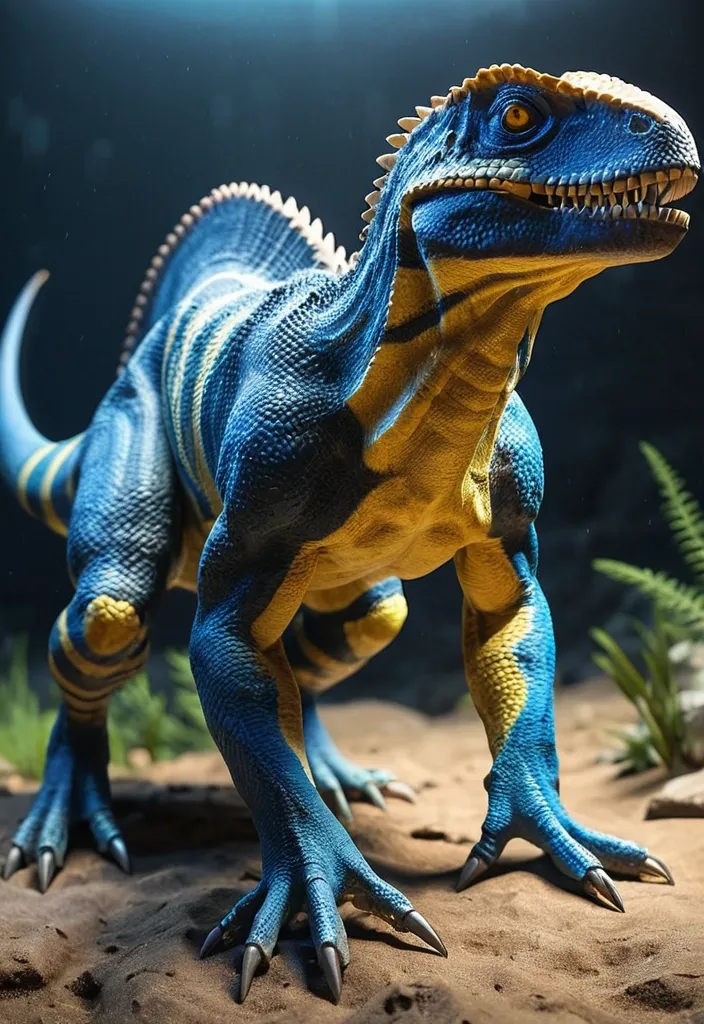
The hybrid was created by modifying the genome of a Tyrannosaurus rex , with the DNA of three other theropod species that were Utahraptor , Saurophaganax , and Giganotosaurus. Also the DNA of Quadrupes like Triceratops , and Scelidosaurus. DNA of modern animals such as Greater blue-ringed octopus , Inland Taipan , Northern Short-tailed Shrew , Komodo Dragon , Opossum , Mongoose , Gigantopithecus , Whiptail Lizard , Cuttlefish , and Tardigrades. The genome of Tyrannosaurus rex , Triceratops and Giganotosaurus was used as the base genome for the hybrid. Including the shape of the head in some parts from Giganotosaurus and Triceratops. It also gave the Indominus rex an incredibly strong bite that could crush bulletproof glass. Utahraptor DNA was added for high levels of intelligence and the ability to make plans , decisions and pack hunting. Reduced hind legs and Ape DNA added Knuckle-walking Quadruped. Triceratops , and Scelidosaurus were added to act as a biological form of armor that absorbed most of the incoming attacks. Northern short-tailed shrew , the Inland taipan's retractable fangs and the Komodo Dragon DNA was used to form the teeth of the Indominus that were used to tear through the flesh and armor of opponents. Saurophaganax and Gigantopithecus DNA added the presence of long strong arms with slashing hook claws and the use of tools. A swipe of the hybrid's claws would take down bigger opponents. While using tools for smaller elusive prey. Cuttlefish genes were intended to help the Venenosus withstand an accelerated growth , but it also added chromatophore cells in the skin so it could change the shape , color , and texture of its skin like a cuttlefish. Opossum , Mongoose and Tardigrades DNA was added for the Venenosus to be more resistant to climate changes , harmful toxins or bacterial infections , while tardigrades also added survival of extreme conditions such as exposure to extreme temperatures , extreme pressures , air deprivation , radiation , dehydration , and starvation. They have several defense mechanisms , including: A metabolic rate that gets as low as 0.01 percent of the normal rate. Organs protected by a sugary gel called trehalose. A protein that shields their DNA from radiation harm. Synthesis of cryoprotectant in chilly temperatures to prevent the development of ice crystals.Northern short-tailed shrew , the Inland Taipan , Greater blue-ringed octopus and the Komodo Dragon's DNA also added special cavities and glands in the skull that gave her infrared vision , and highly toxic saliva. Said DNA also gave her the ability to open her mandibles and jaws as wide as a snake , specifically at around 90 degrees.Lastly , DNA from a whiptail lizard was added for reproduction purposes. ,
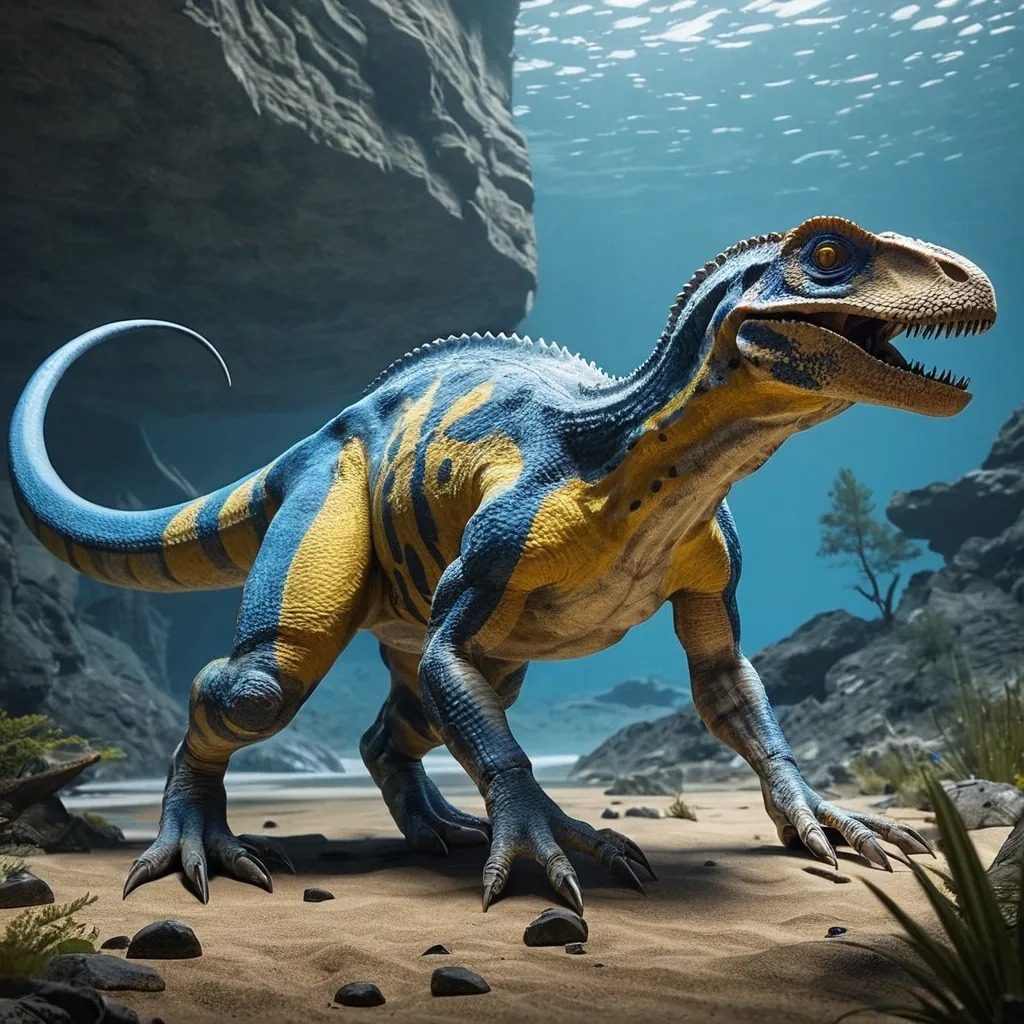
The hybrid was created by modifying the genome of a Tyrannosaurus rex , with the DNA of three other theropod species that were Utahraptor , Saurophaganax , and Giganotosaurus. Also the DNA of Quadrupes like Triceratops , and Scelidosaurus. DNA of modern animals such as Greater blue-ringed octopus , Inland Taipan , Northern Short-tailed Shrew , Komodo Dragon , Opossum , Mongoose , Gigantopithecus , Whiptail Lizard , Cuttlefish , and Tardigrades. The genome of Tyrannosaurus rex , Triceratops and Giganotosaurus was used as the base genome for the hybrid. Including the shape of the head in some parts from Giganotosaurus and Triceratops. It also gave the Indominus rex an incredibly strong bite that could crush bulletproof glass. Utahraptor DNA was added for high levels of intelligence and the ability to make plans , decisions and pack hunting. Reduced hind legs and Ape DNA added Knuckle-walking Quadruped. Triceratops , and Scelidosaurus were added to act as a biological form of armor that absorbed most of the incoming attacks. Northern short-tailed shrew , the Inland taipan's retractable fangs and the Komodo Dragon DNA was used to form the teeth of the Indominus that were used to tear through the flesh and armor of opponents. Saurophaganax and Gigantopithecus DNA added the presence of long strong arms with slashing hook claws and the use of tools. A swipe of the hybrid's claws would take down bigger opponents. While using tools for smaller elusive prey. Cuttlefish genes were intended to help the Venenosus withstand an accelerated growth , but it also added chromatophore cells in the skin so it could change the shape , color , and texture of its skin like a cuttlefish. Opossum , Mongoose and Tardigrades DNA was added for the Venenosus to be more resistant to climate changes , harmful toxins or bacterial infections , while tardigrades also added survival of extreme conditions such as exposure to extreme temperatures , extreme pressures , air deprivation , radiation , dehydration , and starvation. They have several defense mechanisms , including: A metabolic rate that gets as low as 0.01 percent of the normal rate. Organs protected by a sugary gel called trehalose. A protein that shields their DNA from radiation harm. Synthesis of cryoprotectant in chilly temperatures to prevent the development of ice crystals.Northern short-tailed shrew , the Inland Taipan , Greater blue-ringed octopus and the Komodo Dragon's DNA also added special cavities and glands in the skull that gave her infrared vision , and highly toxic saliva. Said DNA also gave her the ability to open her mandibles and jaws as wide as a snake , specifically at around 90 degrees.Lastly , DNA from a whiptail lizard was added for reproduction purposes. ,
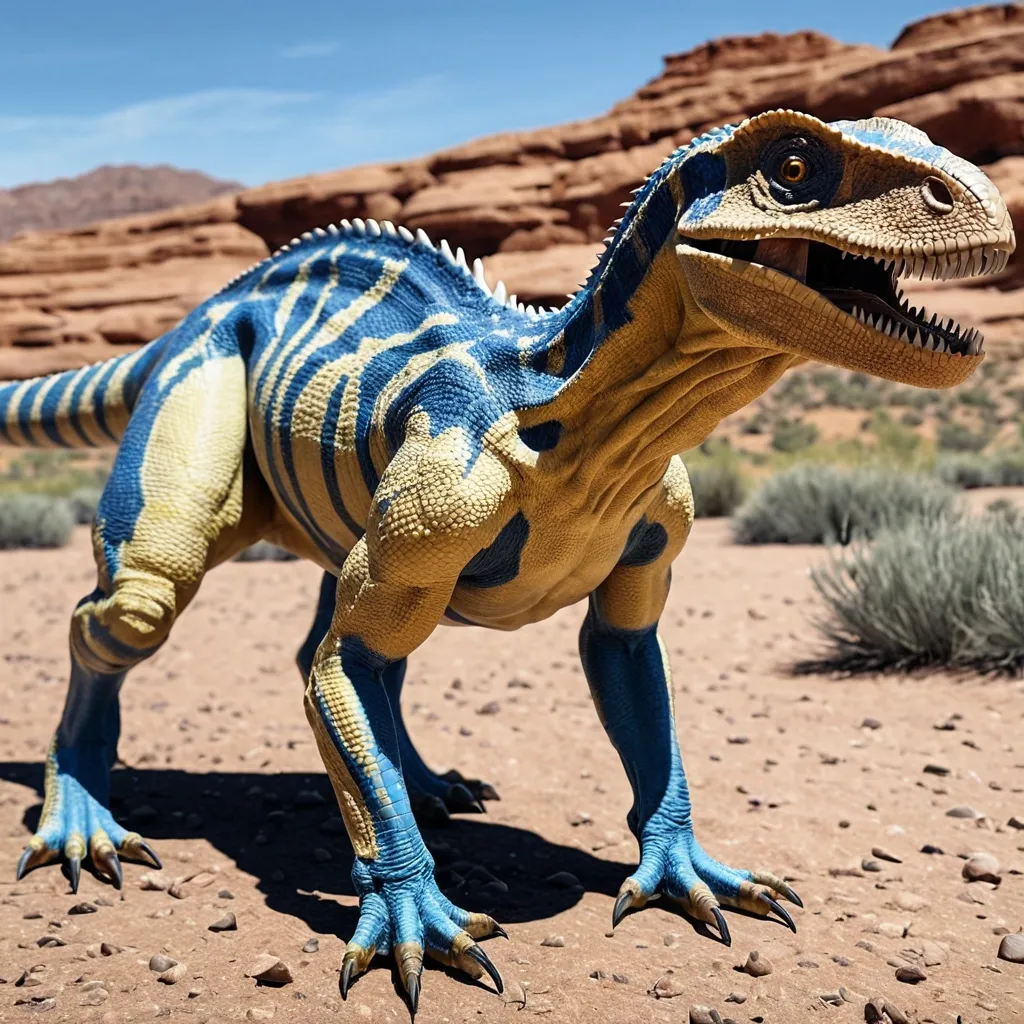
The hybrid was created by modifying the genome of a Tyrannosaurus rex , with the DNA of three other theropod species that were Utahraptor , Saurophaganax , and Giganotosaurus. Also the DNA of Quadrupes like Triceratops , and Scelidosaurus. DNA of modern animals such as Greater blue-ringed octopus , Inland Taipan , Northern Short-tailed Shrew , Komodo Dragon , Opossum , Mongoose , Gigantopithecus , Whiptail Lizard , Cuttlefish , and Tardigrades. The genome of Tyrannosaurus rex , Triceratops and Giganotosaurus was used as the base genome for the hybrid. Including the shape of the head in some parts from Giganotosaurus and Triceratops. It also gave the Indominus rex an incredibly strong bite that could crush bulletproof glass. Utahraptor DNA was added for high levels of intelligence and the ability to make plans , decisions and pack hunting. Reduced hind legs and Ape DNA added Knuckle-walking Quadruped. Triceratops , and Scelidosaurus were added to act as a biological form of armor that absorbed most of the incoming attacks. Northern short-tailed shrew , the Inland taipan's retractable fangs and the Komodo Dragon DNA was used to form the teeth of the Indominus that were used to tear through the flesh and armor of opponents. Saurophaganax and Gigantopithecus DNA added the presence of long strong arms with slashing hook claws and the use of tools. A swipe of the hybrid's claws would take down bigger opponents. While using tools for smaller elusive prey. Cuttlefish genes were intended to help the Venenosus withstand an accelerated growth , but it also added chromatophore cells in the skin so it could change the shape , color , and texture of its skin like a cuttlefish. Opossum , Mongoose and Tardigrades DNA was added for the Venenosus to be more resistant to climate changes , harmful toxins or bacterial infections , while tardigrades also added survival of extreme conditions such as exposure to extreme temperatures , extreme pressures , air deprivation , radiation , dehydration , and starvation. They have several defense mechanisms , including: A metabolic rate that gets as low as 0.01 percent of the normal rate. Organs protected by a sugary gel called trehalose. A protein that shields their DNA from radiation harm. Synthesis of cryoprotectant in chilly temperatures to prevent the development of ice crystals.Northern short-tailed shrew , the Inland Taipan , Greater blue-ringed octopus and the Komodo Dragon's DNA also added special cavities and glands in the skull that gave her infrared vision , and highly toxic saliva. Said DNA also gave her the ability to open her mandibles and jaws as wide as a snake , specifically at around 90 degrees.Lastly , DNA from a whiptail lizard was added for reproduction purposes. ,
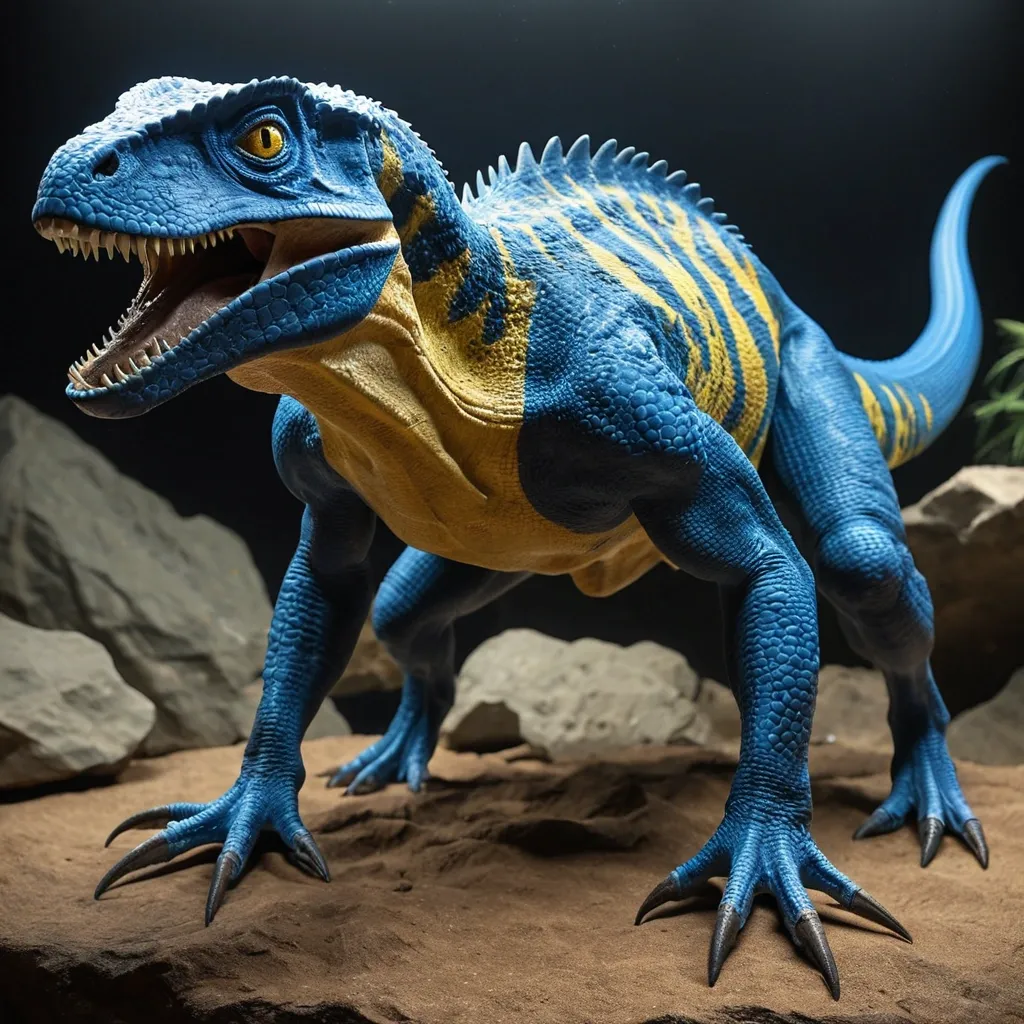
The hybrid was created by modifying the genome of a Tyrannosaurus rex , with the DNA of three other theropod species that were Utahraptor , Saurophaganax , and Giganotosaurus. Also the DNA of Quadrupes like Triceratops , and Scelidosaurus. DNA of modern animals such as Greater blue-ringed octopus , Inland Taipan , Northern Short-tailed Shrew , Komodo Dragon , Opossum , Mongoose , Ape , Whiptail Lizard , Cuttlefish , and Tardigrades. The genome of Tyrannosaurus rex , Triceratops and Giganotosaurus was used as the base genome for the hybrid. Including the shape of the head in some parts from Giganotosaurus and Triceratops. It also gave the Indominus rex an incredibly strong bite that could crush bulletproof glass. Utahraptor DNA was added for high levels of intelligence and the ability to make plans , decisions and pack hunting. Reduced hind legs and Ape DNA added Knuckle-walking Quadruped. Triceratops , and Scelidosaurus were added to act as a biological form of armor that absorbed most of the incoming attacks. Northern short-tailed shrew , the Inland taipan's retractable fangs and the Komodo Dragon DNA was used to form the teeth of the Indominus that were used to tear through the flesh and armor of opponents. Saurophaganax and Gigantopithecus DNA added the presence of long strong arms with slashing hook claws and the use of tools. A swipe of the hybrid's claws would take down bigger opponents. While using tools for smaller elusive prey. Cuttlefish genes were intended to help the Venenosus withstand an accelerated growth , but it also added chromatophore cells in the skin so it could change the shape , color , and texture of its skin like a cuttlefish. Opossum , Mongoose and Tardigrades DNA was added for the Venenosus to be more resistant to climate changes , harmful toxins or bacterial infections , while tardigrades also added survival of extreme conditions such as exposure to extreme temperatures , extreme pressures , air deprivation , radiation , dehydration , and starvation. They have several defense mechanisms , including: A metabolic rate that gets as low as 0.01 percent of the normal rate. Organs protected by a sugary gel called trehalose. A protein that shields their DNA from radiation harm. Synthesis of cryoprotectant in chilly temperatures to prevent the development of ice crystals.Northern short-tailed shrew , the Inland Taipan , Greater blue-ringed octopus and the Komodo Dragon's DNA also added special cavities and glands in the skull that gave her infrared vision , and highly toxic saliva. Said DNA also gave her the ability to open her mandibles and jaws as wide as a snake , specifically at around 90 degrees.Lastly , DNA from a whiptail lizard was added for reproduction purposes. ,
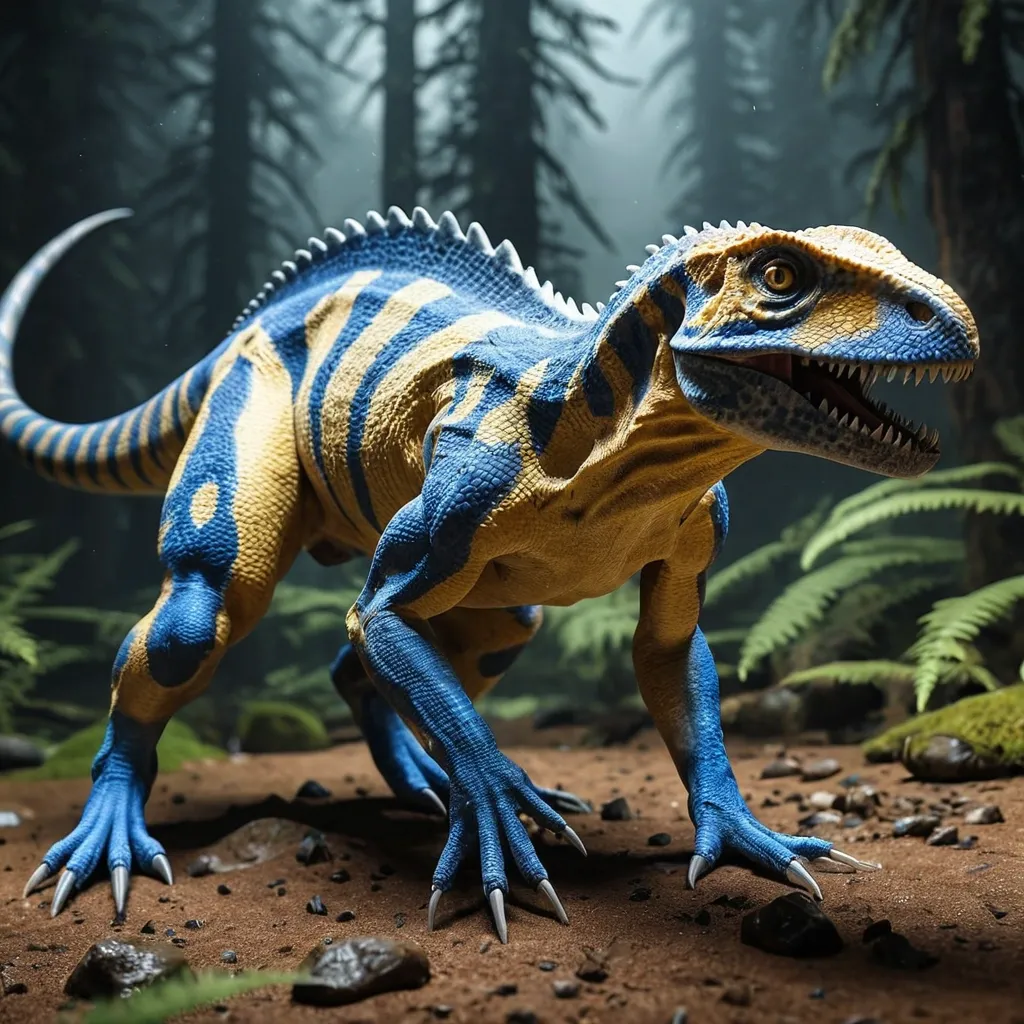
The hybrid was created by modifying the genome of a Tyrannosaurus rex , with the DNA of three other theropod species that were Utahraptor , Saurophaganax , and Giganotosaurus. Also the DNA of Quadrupes like Triceratops , and Scelidosaurus. DNA of modern animals such as Greater blue-ringed octopus , Inland Taipan , Northern Short-tailed Shrew , Komodo Dragon , Opossum , Mongoose , Ape , Whiptail Lizard , Cuttlefish , and Tardigrades. The genome of Tyrannosaurus rex , Triceratops and Giganotosaurus was used as the base genome for the hybrid. Including the shape of the head in some parts from Giganotosaurus and Triceratops. It also gave the Indominus rex an incredibly strong bite that could crush bulletproof glass. Utahraptor DNA was added for high levels of intelligence and the ability to make plans , decisions and pack hunting. Reduced hind legs and Ape DNA added Knuckle-walking Quadruped. Triceratops , and Scelidosaurus were added to act as a biological form of armor that absorbed most of the incoming attacks. Northern short-tailed shrew , the Inland taipan's retractable fangs and the Komodo Dragon DNA was used to form the teeth of the Indominus that were used to tear through the flesh and armor of opponents. Saurophaganax and Ape DNA added the presence of long strong arms with slashing hook claws and the use of tools. A swipe of the hybrid's claws would take down bigger opponents. While using tools for smaller elusive prey. Cuttlefish genes were intended to help the Venenosus withstand an accelerated growth , but it also added chromatophore cells in the skin so it could change the shape , color , and texture of its skin like a cuttlefish. Opossum , Mongoose and Tardigrades DNA was added for the Venenosus to be more resistant to climate changes , harmful toxins or bacterial infections , while tardigrades also added survival of extreme conditions such as exposure to extreme temperatures , extreme pressures , air deprivation , radiation , dehydration , and starvation. They have several defense mechanisms , including: A metabolic rate that gets as low as 0.01 percent of the normal rate. Organs protected by a sugary gel called trehalose. A protein that shields their DNA from radiation harm. Synthesis of cryoprotectant in chilly temperatures to prevent the development of ice crystals.Northern short-tailed shrew , the Inland Taipan , Greater blue-ringed octopus and the Komodo Dragon's DNA also added special cavities and glands in the skull that gave her infrared vision , and highly toxic saliva. Said DNA also gave her the ability to open her mandibles and jaws as wide as a snake , specifically at around 90 degrees.Lastly , DNA from a whiptail lizard was added for reproduction purposes. ,
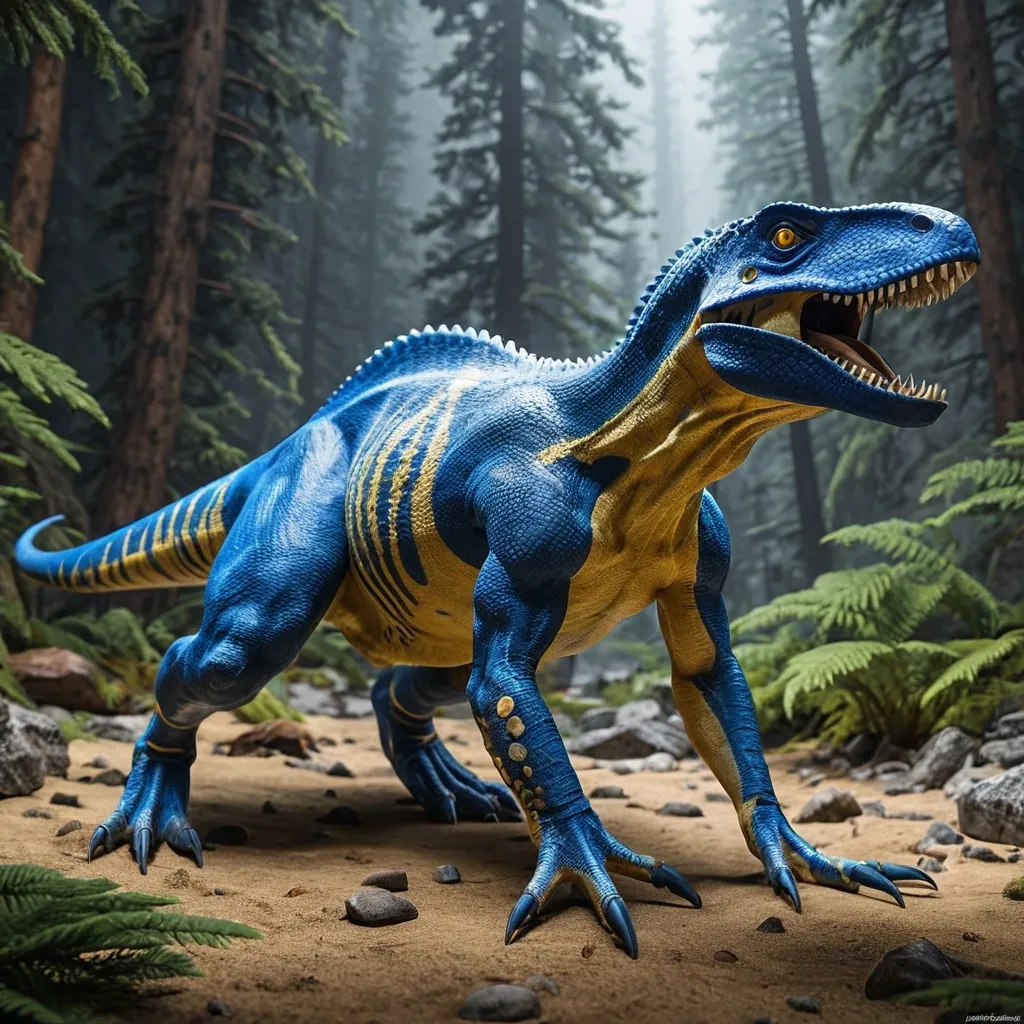
The hybrid was created by modifying the genome of a Tyrannosaurus rex , with the DNA of three other theropod species that were Utahraptor , Saurophaganax , and Giganotosaurus. Also the DNA of Quadrupes like Triceratops , and Scelidosaurus. DNA of modern animals such as Greater blue-ringed octopus , Inland Taipan , Northern Short-tailed Shrew , Komodo Dragon , Opossum , Mongoose , Ape , Whiptail Lizard , Cuttlefish , and Tardigrades. The genome of Tyrannosaurus rex , Triceratops and Giganotosaurus was used as the base genome for the hybrid. Including the shape of the head in some parts from Giganotosaurus and Triceratops. It also gave the Indominus rex an incredibly strong bite that could crush bulletproof glass. Utahraptor DNA was added for high levels of intelligence and the ability to make plans , decisions and pack hunting. Reduced hind legs and Ape DNA added Knuckle-walking Quadruped. Triceratops , and Scelidosaurus were added to act as a biological form of armor that absorbed most of the incoming attacks. Northern short-tailed shrew , the Inland taipan's retractable fangs and the Komodo Dragon DNA was used to form the teeth of the Indominus that were used to tear through the flesh and armor of opponents. Saurophaganax and Ape DNA added the presence of long strong arms with slashing hook claws and the use of tools. A swipe of the hybrid's claws would take down bigger opponents. While using tools for smaller elusive prey. Cuttlefish genes were intended to help the Venenosus withstand an accelerated growth , but it also added chromatophore cells in the skin so it could change the shape , color , and texture of its skin like a cuttlefish. Opossum , Mongoose and Tardigrades DNA was added for the Venenosus to be more resistant to climate changes , harmful toxins or bacterial infections , while tardigrades also added survival of extreme conditions such as exposure to extreme temperatures , extreme pressures , air deprivation , radiation , dehydration , and starvation. They have several defense mechanisms , including: A metabolic rate that gets as low as 0.01 percent of the normal rate. Organs protected by a sugary gel called trehalose. A protein that shields their DNA from radiation harm. Synthesis of cryoprotectant in chilly temperatures to prevent the development of ice crystals.Northern short-tailed shrew , the Inland Taipan , Greater blue-ringed octopus and the Komodo Dragon's DNA also added special cavities and glands in the skull that gave her infrared vision , and highly toxic saliva. Said DNA also gave her the ability to open her mandibles and jaws as wide as a snake , specifically at around 90 degrees.Lastly , DNA from a whiptail lizard was added for reproduction purposes. ,
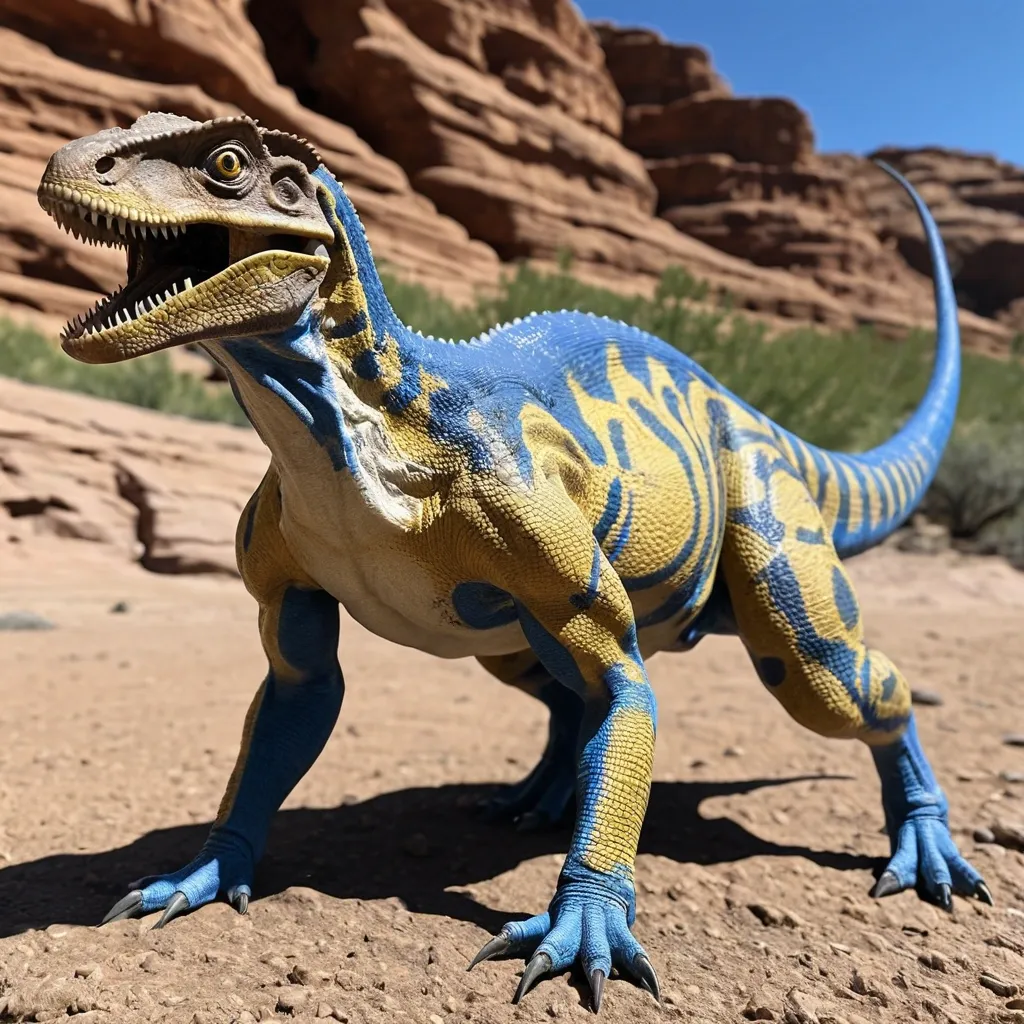
The hybrid was created by modifying the genome of a Tyrannosaurus rex , with the DNA of three other theropod species that were Utahraptor , Saurophaganax , and Giganotosaurus. Also the DNA of Quadrupes like Triceratops , and Scelidosaurus. DNA of modern animals such as Greater blue-ringed octopus , Inland Taipan , Northern Short-tailed Shrew , Komodo Dragon , Opossum , Mongoose , Ape , Whiptail Lizard , Cuttlefish , and Tardigrades. The genome of Tyrannosaurus rex , Triceratops and Giganotosaurus was used as the base genome for the hybrid. Including the shape of the head in some parts from Giganotosaurus and Triceratops. It also gave the Indominus rex an incredibly strong bite that could crush bulletproof glass. Utahraptor DNA was added for high levels of intelligence and the ability to make plans , decisions and pack hunting. Reduced hind legs and Ape DNA added Knuckle-walking Quadruped. Triceratops , and Scelidosaurus were added to act as a biological form of armor that absorbed most of the incoming attacks. Northern short-tailed shrew , the Inland taipan's retractable fangs and the Komodo Dragon DNA was used to form the teeth of the Indominus that were used to tear through the flesh and armor of opponents. Saurophaganax and Ape DNA added the presence of long strong arms with slashing hook claws and the use of tools. A swipe of the hybrid's claws would take down bigger opponents. While using tools for smaller elusive prey. Cuttlefish genes were intended to help the Venenosus withstand an accelerated growth , but it also added chromatophore cells in the skin so it could change the shape , color , and texture of its skin like a cuttlefish. Opossum , Mongoose and Tardigrades DNA was added for the Venenosus to be more resistant to climate changes , harmful toxins or bacterial infections , while tardigrades also added survival of extreme conditions such as exposure to extreme temperatures , extreme pressures , air deprivation , radiation , dehydration , and starvation. They have several defense mechanisms , including: A metabolic rate that gets as low as 0.01 percent of the normal rate. Organs protected by a sugary gel called trehalose. A protein that shields their DNA from radiation harm. Synthesis of cryoprotectant in chilly temperatures to prevent the development of ice crystals.Northern short-tailed shrew , the Inland Taipan , Greater blue-ringed octopus and the Komodo Dragon's DNA also added special cavities and glands in the skull that gave her infrared vision , and highly toxic saliva. Said DNA also gave her the ability to open her mandibles and jaws as wide as a snake , specifically at around 90 degrees.Lastly , DNA from a whiptail lizard was added for reproduction purposes. ,
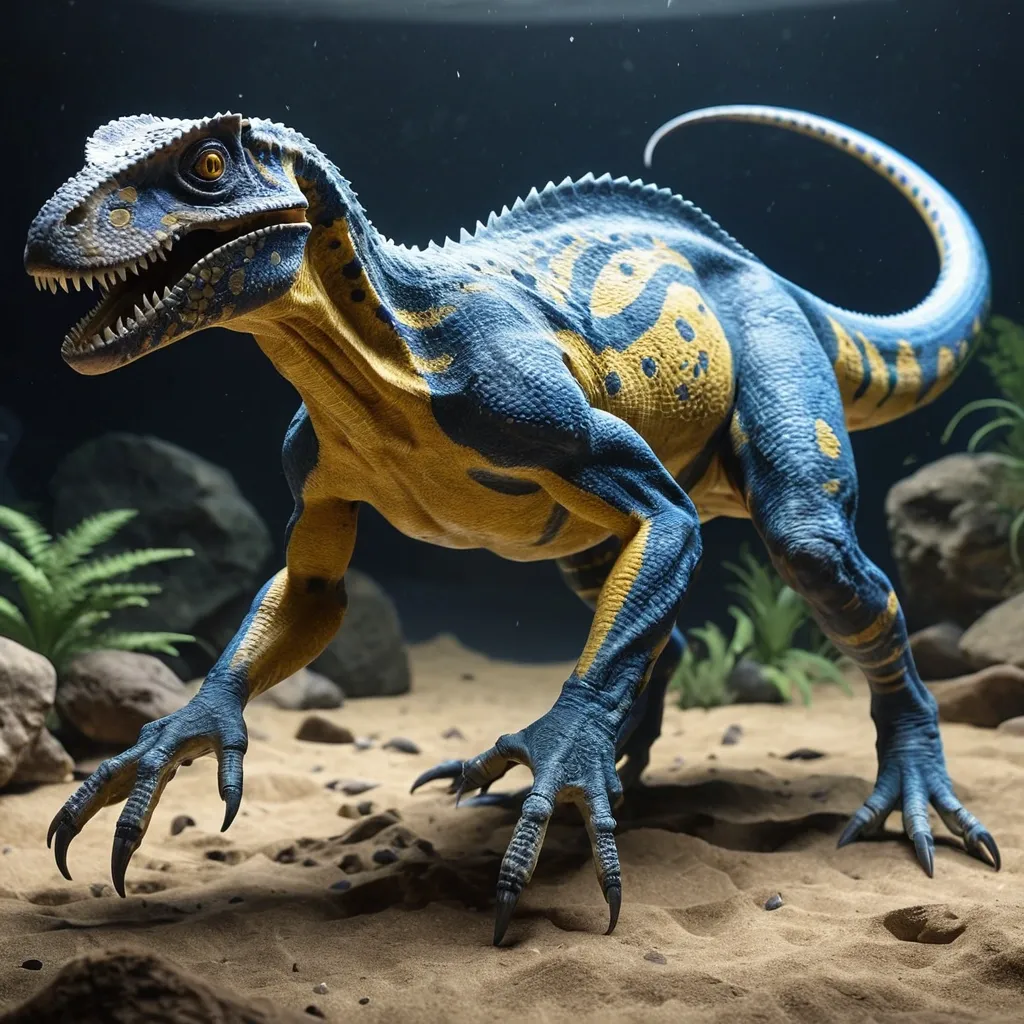
The hybrid was created by modifying the genome of a Tyrannosaurus rex , with the DNA of three other theropod species that were Utahraptor , Saurophaganax , and Giganotosaurus. Also the DNA of Quadrupes like Triceratops , and Scelidosaurus. DNA of modern animals such as Greater blue-ringed octopus , Inland Taipan , Northern Short-tailed Shrew , Komodo Dragon , Opossum , Mongoose , Ape , Whiptail Lizard , Cuttlefish , and Tardigrades. The genome of Tyrannosaurus rex , Triceratops and Giganotosaurus was used as the base genome for the hybrid. Including the shape of the head in some parts from Giganotosaurus and Triceratops. It also gave the Indominus rex an incredibly strong bite that could crush bulletproof glass. Utahraptor DNA was added for high levels of intelligence and the ability to make plans , decisions and pack hunting. Reduced hind legs and Ape DNA added Knuckle-walking Quadruped. Triceratops , and Scelidosaurus were added to act as a biological form of armor that absorbed most of the incoming attacks. Northern short-tailed shrew , the Inland taipan's retractable fangs and the Komodo Dragon DNA was used to form the teeth of the Indominus that were used to tear through the flesh and armor of opponents. Saurophaganax and Ape DNA added the presence of long strong arms with slashing hook claws and the use of tools. A swipe of the hybrid's claws would take down bigger opponents. While using tools for smaller elusive prey. Cuttlefish genes were intended to help the Venenosus withstand an accelerated growth , but it also added chromatophore cells in the skin so it could change the shape , color , and texture of its skin like a cuttlefish. Opossum , Mongoose and Tardigrades DNA was added for the Venenosus to be more resistant to climate changes , harmful toxins or bacterial infections , while tardigrades also added survival of extreme conditions such as exposure to extreme temperatures , extreme pressures , air deprivation , radiation , dehydration , and starvation. They have several defense mechanisms , including: A metabolic rate that gets as low as 0.01 percent of the normal rate. Organs protected by a sugary gel called trehalose. A protein that shields their DNA from radiation harm. Synthesis of cryoprotectant in chilly temperatures to prevent the development of ice crystals.Northern short-tailed shrew , the Inland Taipan , Greater blue-ringed octopus and the Komodo Dragon's DNA also added special cavities and glands in the skull that gave her infrared vision , and highly toxic saliva. Said DNA also gave her the ability to open her mandibles and jaws as wide as a snake , specifically at around 90 degrees.Lastly , DNA from a whiptail lizard was added for reproduction purposes. ,
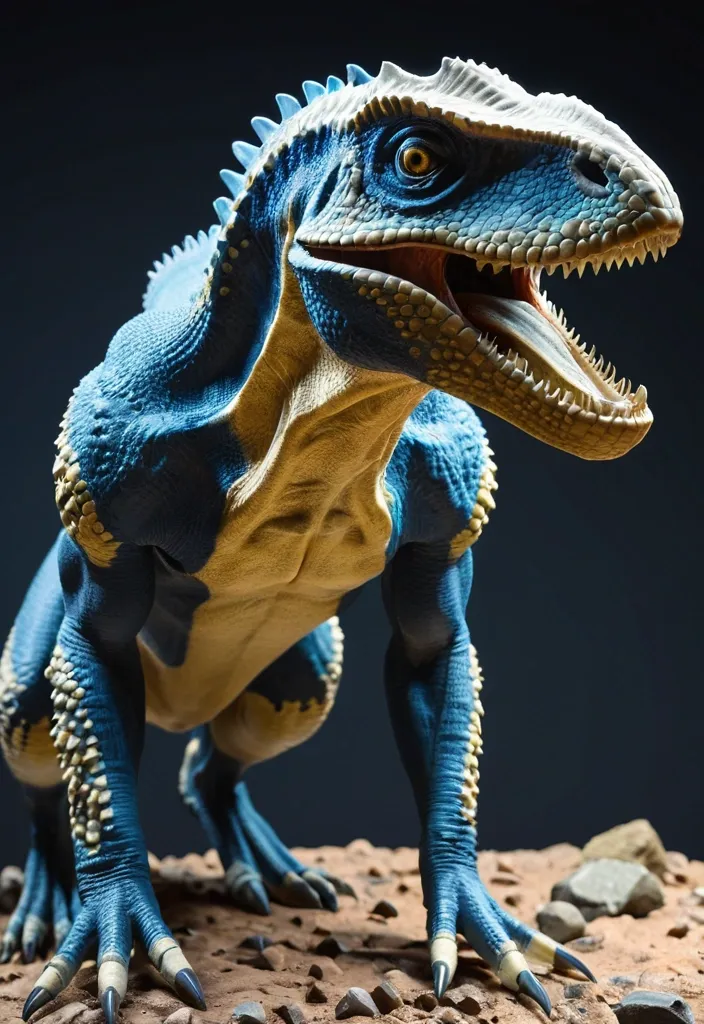
The hybrid was created by modifying the genome of a Tyrannosaurus rex , with the DNA of three other theropods. Known species that were included were Utahraptor , Saurophaganax , and Giganotosaurus. There was also the DNA of Quadrupes like Triceratops , and Scelidosaurus. DNA of modern animals such as Greater blue-ringed octopus , Inland Taipan , Northern Short-tailed Shrew , Komodo Dragon , Opossum , Mongoose , Ape , Whiptail Lizard , Cuttlefish , and Tardigrades. The genome of Tyrannosaurus rex , Triceratops and Giganotosaurus was used as the base genome for the hybrid. Including the shape of the head in some parts from Giganotosaurus and Triceratops. It also gave the Indominus rex an incredibly strong bite that could crush bulletproof glass. Utahraptor DNA was added for high levels of intelligence and the ability to make plans , decisions and pack hunting. Reduced hind legs and Ape DNA added Knuckle-walking Quadruped. Triceratops , and Scelidosaurus were added to act as a biological form of armor that absorbed most of the incoming attacks. Northern short-tailed shrew , the Inland taipan's retractable fangs and the Komodo Dragon DNA was used to form the teeth of the Indominus that were used to tear through the flesh and armor of opponents. Saurophaganax and Ape DNA added the presence of long strong arms with slashing hook claws and the use of tools. A swipe of the hybrid's claws would take down bigger opponents. While using tools for smaller elusive prey. Cuttlefish genes were intended to help the Venenosus withstand an accelerated growth , but it also added chromatophore cells in the skin so it could change the shape , color , and texture of its skin like a cuttlefish. Opossum , Mongoose and Tardigrades DNA was added for the Venenosus to be more resistant to climate changes , harmful toxins or bacterial infections , while tardigrades also added survival of extreme conditions such as exposure to extreme temperatures , extreme pressures , air deprivation , radiation , dehydration , and starvation. They have several defense mechanisms , including: A metabolic rate that gets as low as 0.01 percent of the normal rate. Organs protected by a sugary gel called trehalose. A protein that shields their DNA from radiation harm. Synthesis of cryoprotectant in chilly temperatures to prevent the development of ice crystals.Northern short-tailed shrew , the Inland Taipan , Greater blue-ringed octopus and the Komodo Dragon's DNA also added special cavities and glands in the skull that gave her infrared vision , and highly toxic saliva. Said DNA also gave her the ability to open her mandibles and jaws as wide as a snake , specifically at around 90 degrees.Lastly , DNA from a whiptail lizard was added for reproduction purposes. ,
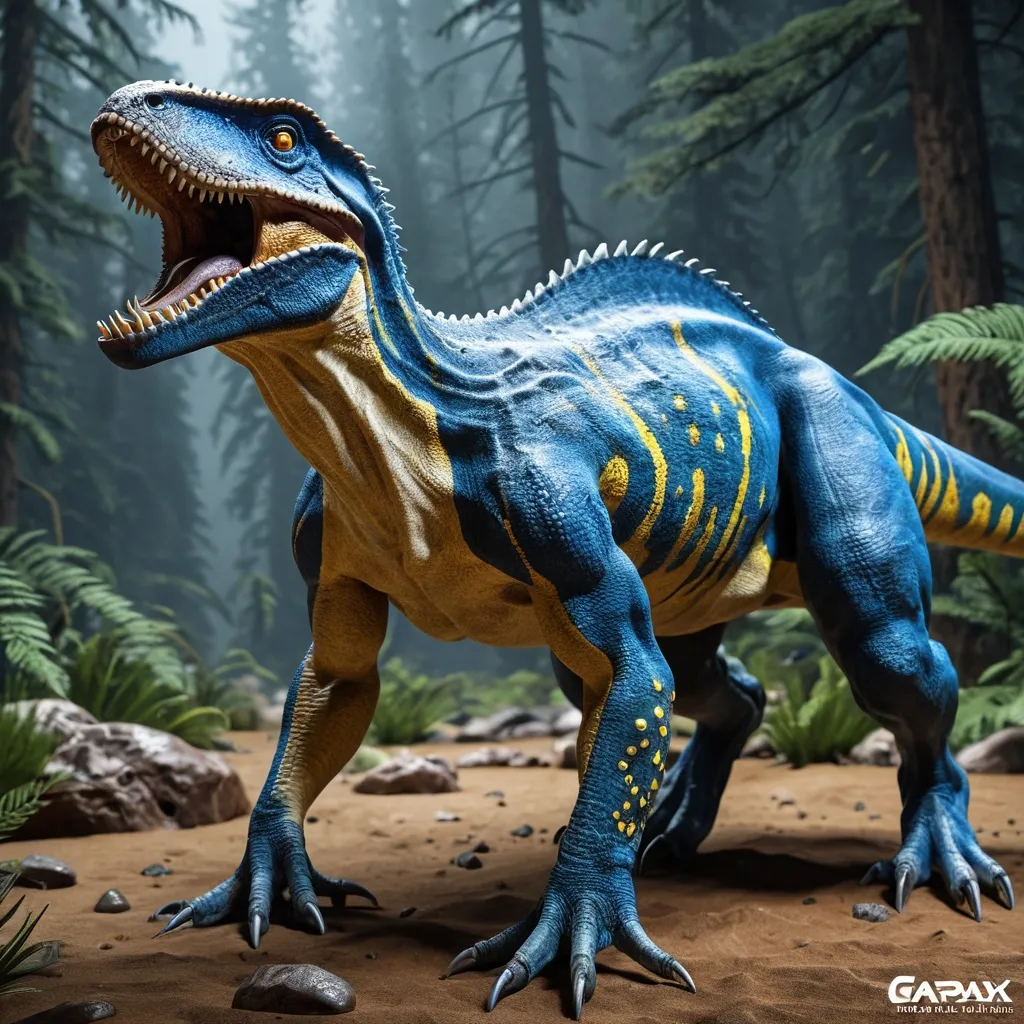
The hybrid was created by modifying the genome of a Tyrannosaurus rex , with the DNA of three other theropods. Known species that were included were Utahraptor , Saurophaganax , and Giganotosaurus. There was also the DNA of Quadrupes like Triceratops , and Scelidosaurus. DNA of modern animals such as Greater blue-ringed octopus , Inland Taipan , Northern Short-tailed Shrew , Komodo Dragon , Opossum , Mongoose , Ape , Whiptail Lizard , Cuttlefish , and Tardigrades. The genome of Tyrannosaurus rex , Triceratops and Giganotosaurus was used as the base genome for the hybrid. Including the shape of the head in some parts from Giganotosaurus and Triceratops. It also gave the Indominus rex an incredibly strong bite that could crush bulletproof glass. Utahraptor DNA was added for high levels of intelligence and the ability to make plans , decisions and pack hunting. Reduced hind legs and Ape DNA added Knuckle-walking Quadruped. Triceratops , and Scelidosaurus were added to act as a biological form of armor that absorbed most of the incoming attacks. Northern short-tailed shrew , the Inland taipan's retractable fangs and the Komodo Dragon DNA was used to form the teeth of the Indominus that were used to tear through the flesh and armor of opponents. Saurophaganax and Ape DNA added the presence of long strong arms with slashing hook claws and the use of tools. A swipe of the hybrid's claws would take down bigger opponents. While using tools for smaller elusive prey. Cuttlefish genes were intended to help the Venenosus withstand an accelerated growth , but it also added chromatophore cells in the skin so it could change the shape , color , and texture of its skin like a cuttlefish. Opossum , Mongoose and Tardigrades DNA was added for the Venenosus to be more resistant to climate changes , harmful toxins or bacterial infections , while tardigrades also added survival of extreme conditions such as exposure to extreme temperatures , extreme pressures , air deprivation , radiation , dehydration , and starvation. They have several defense mechanisms , including: A metabolic rate that gets as low as 0.01 percent of the normal rate. Organs protected by a sugary gel called trehalose. A protein that shields their DNA from radiation harm. Synthesis of cryoprotectant in chilly temperatures to prevent the development of ice crystals.Northern short-tailed shrew , the Inland Taipan , Greater blue-ringed octopus and the Komodo Dragon's DNA also added special cavities and glands in the skull that gave her infrared vision , and highly toxic saliva. Said DNA also gave her the ability to open her mandibles and jaws as wide as a snake , specifically at around 90 degrees.Lastly , DNA from a whiptail lizard was added for reproduction purposes. ,